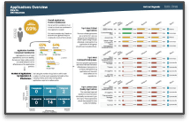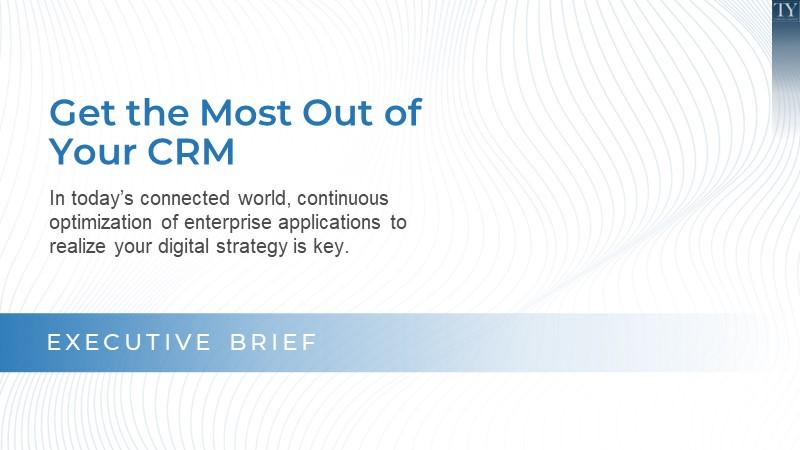
Get the Most Out of Your CRM
- Application optimization is essential to stay competitive and productive in today’s digital environment.
- Enterprise applications often involve large capital outlay, unquantified benefits, and high risk of failure.
- Customer relationship management (CRM) application portfolios are often messy with multiple integration points, distributed data, and limited ongoing end-user training.
- User dissatisfaction is common.
Our Advice
Critical Insight
A properly optimized CRM ecosystem will reduce costs and increase productivity.
Impact and Result
- Build an ongoing optimization team to conduct application improvements.
- Assess your CRM application(s) and the environment in which they exist. Take a business-first strategy to prioritize optimization efforts.
- Validate CRM capabilities, user satisfaction, issues around data, vendor management, and costs to build out an optimization strategy.
- Pull this all together to develop a prioritized optimization roadmap.
Get the Most Out of Your CRM Research & Tools
Start here – read the Executive Brief
Read our concise Executive Brief to find out why you should optimize your CRM, review Info-Tech’s methodology, and understand the four ways we can support you in completing this project.Besides the small introduction, subscribers and consulting clients within this management domain have access to:
- Get the Most Out of Your CRM – Phases 1-3
1. Map current-state capabilities
Gather information around the application:
- Get the Most Out of Your CRM Workbook
2. Assess your current state
Assess CRM and related environment. Perform CRM process assessment. Assess user satisfaction across key processes, applications, and data. Understand vendor satisfaction
- CRM Application Inventory Tool
3. Build your optimization roadmap
Build your optimization roadmap: process improvements, software capability improvements, vendor relationships, and data improvement initiatives.
Infographic

Workshop: Get the Most Out of Your CRM
Workshops offer an easy way to accelerate your project. If you are unable to do the project yourself, and a Guided Implementation isn't enough, we offer low-cost delivery of our project workshops. We take you through every phase of your project and ensure that you have a roadmap in place to complete your project successfully.
1 Define Your CRM Application Vision
The Purpose
Define your CRM application vision.
Key Benefits Achieved
Develop an ongoing application optimization team.
Realign CRM and business goals.
Understand your current system state capabilities.
Explore CRM and related costs.
Activities
1.1 Determine your CRM optimization team.
1.2 Align organizational goals.
1.3 Inventory applications and interactions.
1.4 Define business capabilities.
1.5 Explore CRM-related costs (optional).
Outputs
CRM optimization team
CRM business model
CRM optimization goals
CRM system inventory and data flow
CRM process list
CRM and related costs
2 Map Current-State Capabilities
The Purpose
Map current-state capabilities.
Key Benefits Achieved
Complete a CRM process gap analysis to understand where the CRM is underperforming.
Review the CRM application portfolio assessment to understand user satisfaction and data concerns.
Undertake a software review survey to understand your satisfaction with the vendor and product.
Activities
2.1 Conduct gap analysis for CRM processes.
2.2 Perform an application portfolio assessment.
2.3 Review vendor satisfaction.
Outputs
CRM process gap analysis
CRM application portfolio assessment
CRM software reviews survey
3 Assess CRM
The Purpose
Assess CRM.
Key Benefits Achieved
Learn which processes you need to focus on.
Uncover underlying user satisfaction issues to address these areas.
Understand where data issues are occurring so that you can mitigate this.
Investigate your relationship with the vendor and product, including that relative to others.
Identify any areas for cost optimization (optional).
Activities
3.1 Explore process gaps.
3.2 Analyze user satisfaction.
3.3 Assess data quality.
3.4 Understand product satisfaction and vendor management.
3.5 Look for CRM cost optimization opportunities (optional).
Outputs
CRM process optimization priorities
CRM vendor optimization opportunities
CRM cost optimization
4 Build the Optimization Roadmap
The Purpose
Build the optimization roadmap.
Key Benefits Achieved
Understanding where you need to improve is the first step, now understand where to focus your optimization efforts.
Activities
4.1 Identify key optimization areas.
4.2 Build your CRM optimization roadmap and next steps.
Outputs
CRM optimization roadmap
Further reading
Get the Most Out of Your CRM
In today’s connected world, continuous optimization of enterprise applications to realize your digital strategy is key.
Get the Most Out of Your CRM
In today’s connected world, continuous optimization of enterprise applications to realize your digital strategy is key.
EXECUTIVE BRIEF
Analyst Perspective
Focus optimization on organizational value delivery.
Customer relationship management (CRM) systems are at the core of a customer-centric strategy to drive business results. They are critical to supporting marketing, sales, and customer service efforts.
CRM systems are expensive, their benefits are difficult to quantify, and they often suffer from poor user satisfaction. Post implementation, technology evolves, organizational goals change, and the health of the system is not monitored. This is complicated in today’s digital landscape with multiple integration points, siloed data, and competing priorities.
Too often organizations jump into the selection of replacement systems without understanding the health of their current systems. IT leaders need to stop reacting and take a proactive approach to continually monitor and optimize their enterprise applications. Strategically realign business goals, identify business application capabilities, complete a process assessment, evaluate user adoption, and create an optimization roadmap that will drive a cohesive technology strategy that delivers results.
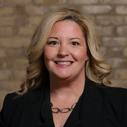
Lisa Highfield
Research Director,
Enterprise Applications
Info-Tech Research Group
Executive Summary
Your Challenge
In today’s connected world, continuous optimization of enterprise applications to realize your digital strategy is key.
Enterprise applications often involve large capital outlay and unquantified benefits.
CRM application portfolios are often messy. Add to that poor processes, distributed data, and lack of training – business results and user dissatisfaction is common.
Technology owners are often distributed across the business. Consolidation of optimization efforts is key.
Common Obstacles
Enterprise applications involve large numbers of processes and users. Without a clear focus on organizational needs, decisions about what and how to optimize can become complicated.
Competing and conflicting priorities may undermine optimization value by focusing on the approaches that would only benefit one line of business rather than the entire organization.
Teams do not have a framework to illustrate, communicate, and justify the optimization effort in the language your stakeholders understand.
Info-Tech’s Approach
Build an ongoing optimization team to conduct application improvements.
Assess your CRM application(s) and the environment in which they exist. Take a business-first strategy to prioritize optimization efforts.
Validate CRM capabilities, user satisfaction, issues around data, vendor management, and costs to build out an optimization strategy
Pull this all together to develop a prioritized optimization roadmap.
Info-Tech Insight
CRM implementation should not be a one-and-done exercise. A properly optimized CRM ecosystem will reduce costs and increase productivity.
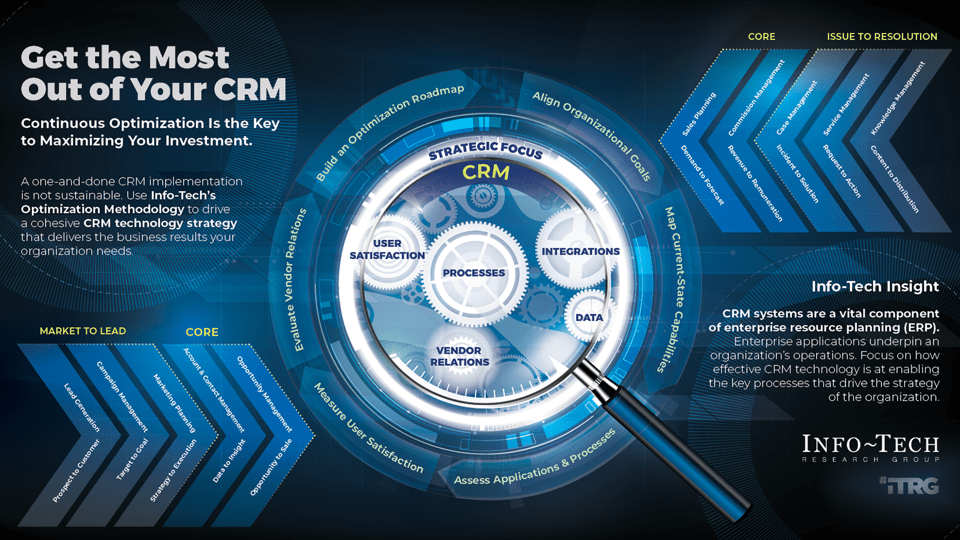
Insight Summary
Continuous assessment and optimization of customer relationship management (CRM) systems is critical to their success.
- Applications and the environments in which they live are constantly evolving.
- Get the Most Out of Your CRM provides business and application managers a method to complete a health assessment on their CRM systems to identify areas for improvement and optimization.
- Put optimization practices into effect by:
- Aligning and prioritizing key business and technology drivers.
- Identifying CRM process classification, and performing a gap analysis.
- Measuring user satisfaction across key departments.
- Evaluating vendor relations.
- Understanding how data fits.
- Pulling it all together into an optimization roadmap.
CRM platforms are the applications that provide functional capabilities and data management around the customer experience (CX).
Marketing, sales, and customer service are enabled through CRM technology.
CRM technologies facilitate an organization’s relationships with customers, service users, employees, and suppliers.
CRM technology is critical to managing the lifecycle of these relationships, from lead generation, to sales opportunities, to ongoing support and nurturing of these relationships.
Customer experience management (CXM)
CRM platforms sit at the core of a well-rounded customer experience management ecosystem.
Customer Relationship Management
- Web Experience Management Platform
- E-Commerce & Point-of-Sale Solutions
- Social Media Management Platform
- Customer Intelligence Platform
- Customer Service Management Tools
- Marketing Management Suite
Customer relationship management suites are one piece of the overall customer experience management ecosystem, alongside tools such as customer intelligence platforms and adjacent point solutions for sales, marketing, and customer service. Review Info-Tech’s CXM blueprint to build a complete, end-to-end customer interaction solution portfolio that encompasses CRM alongside other critical components. The CXM blueprint also allows you to develop strategic requirements for CRM based on customer personas and external market analysis.
CRM by the numbers
1/3
Statistical analysis of CRM projects indicate failures vary from 18% to 69%. Taking an average of those analyst reports, about one-third of CRM projects are considered a failure.
Source: CIO Magazine, 2017
85%
Companies that apply the principles of behavioral economics outperform their peers by 85% in sales growth and more than 25% in gross margin.
Source: Gallup, 2012
40%
In 2019, 40% of executives name customer experience the top priority for their digital transformation.
Source: CRM Magazine, 2019
CRM dissatisfaction
Drivers of Dissatisfaction |
|||
|---|---|---|---|
| Business | Data | People and Teams | Technology |
|
|
|
|
Info-Tech Insight
While technology is the key enabler of building strong customer experiences, there are many other drivers of dissatisfaction. IT must stand shoulder to shoulder with the business to develop a technology framework for customer relationship management.
Marketing, Sales, and Customer Service, along with IT, can only optimize CRM with the full support of each other. The cooperation of the departments is crucial when trying to improve CRM technology capabilities and customer interaction.
Application optimization is risky without a plan
Avoid the common pitfalls.
- Not considering application optimization as a business and IT partnership that requires continuous formal engagement of all participants.
- Not having a good understanding of current state, including integration points and data.
- Not adequately accommodating feedback and changes after digital applications are deployed and employed.
- Not treating digital applications as a motivator for potential future IT optimization effort, and not incorporating digital assets in strategic business planning.
- Not involving department leads, management, and other subject matter experts to facilitate the organizational change digital applications bring.
“A successful application optimization strategy starts with the business need in mind and not from a technological point of view. No matter from which angle you look at it, modernizing a legacy application is a considerable undertaking that can’t be taken lightly. Your best approach is to begin the journey with baby steps.”
– Ernese Norelus, Sreeni Pamidala, and Oliver Senti
Medium, 2020
Info-Tech’s methodology for Get the Most Out of Your CRM
| 1. Map Current-State Capabilities | 2. Assess Your Current State | 3. Build Your Optimization Roadmap | |
|---|---|---|---|
| Phase Steps |
|
|
|
| Phase Outcomes |
|
|
|
Get the Most Out of Your CRM Workbook
Each step of this blueprint is accompanied by supporting deliverables to help you accomplish your goals.
Key deliverable:
CRM Optimization Roadmap (Tab 8)
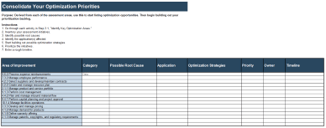
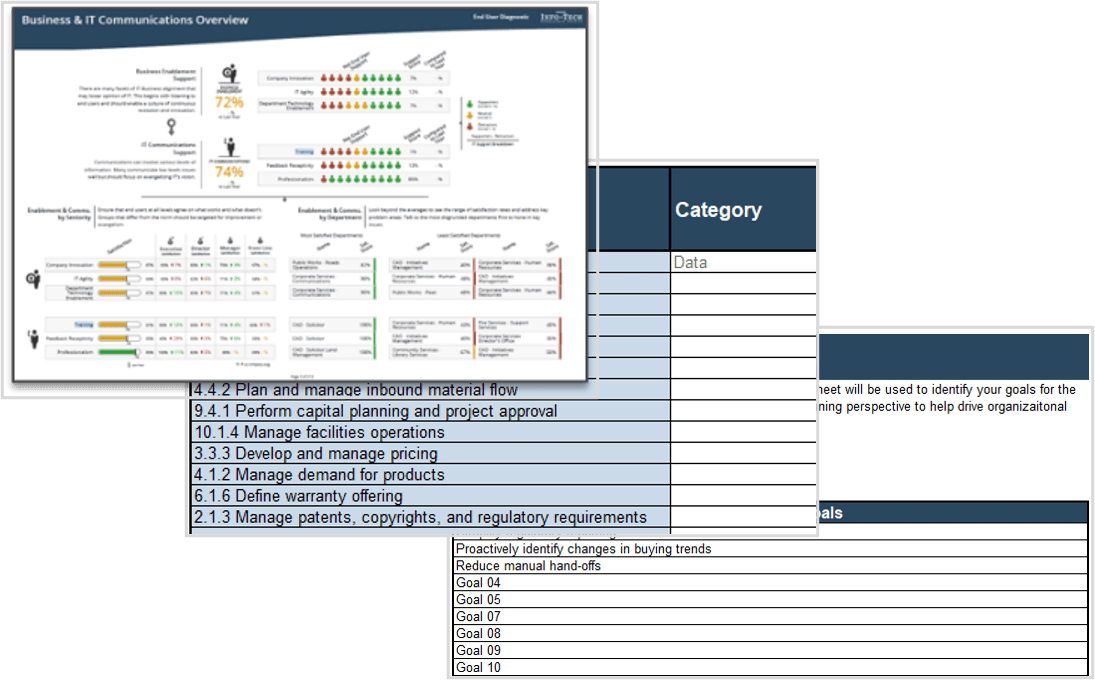
Complete an assessment of processes, user satisfaction, data quality, and vendor management using the Workbook or the APA diagnostic.
CRM Business Model (Tab 2)
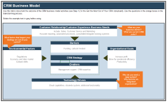
Align your business and technology goals and objectives in the current environment.
Prioritized CRM Optimization Goals (Tab 3)
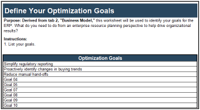
Identify and prioritize your CRM optimization goals.
Application Portfolio Assessment (APA)

Assess IT-enabled user satisfaction across your CRM portfolio.
Prioritized Process Assessment (Tab 5)
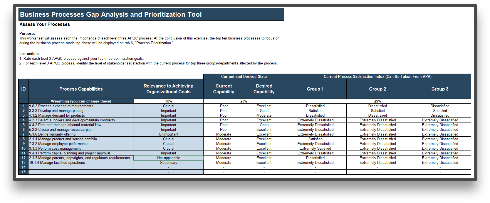
Understand areas for improvement.
Case Study
Align strategy and technology to meet consumer demand.
INDUSTRY - Entertainment
SOURCE - Forbes, 2017
Challenge
Beginning as a mail-out service, Netflix offered subscribers a catalog of videos to select from and have mailed to them directly. Customers no longer had to go to a retail store to rent a video. However, the lack of immediacy of direct mail as the distribution channel resulted in slow adoption.
Blockbuster was the industry leader in video retail but was lagging in its response to industry, consumer, and technology trends around customer experience
Solution
In response to the increasing presence of tech-savvy consumers on the internet, Netflix invested in developing its online platform as its primary distribution channel. The benefit of doing so was two-fold: passive brand advertising (by being present on the internet) and meeting customer demands for immediacy and convenience. Netflix also recognized the rising demand for personalized service and created an unprecedented, tailored customer experience.
Results
Netflix’s disruptive innovation is built on the foundation of great customer experience management. Netflix is now a $28-billion company, which is tenfold what Blockbuster was worth.
Netflix used disruptive technologies to innovatively build a customer experience that put it ahead of the long-time, video rental industry leader, Blockbuster.
Info-Tech offers various levels of support to best suit your needs
DIY Toolkit
“Our team has already made this critical project a priority, and we have the time and capability, but some guidance along the way would be helpful.”
Guided Implementation
“Our team knows that we need to fix a process, but we need assistance to determine where to focus. Some check-ins along the way would help keep us on track.”
Workshop
“We need to hit the ground running and get this project kicked off immediately. Our team has the ability to take this over once we get a framework and strategy in place.”
Consulting
“Our team does not have the time or the knowledge to take this project on. We need assistance through the entirety of this project.”
Diagnostics and consistent frameworks used throughout all four options
Guided Implementation
What does a typical GI on this topic look like?
| Phase 1 | Phase 2 | Phase 3 | ||
|---|---|---|---|---|
Call #1: Scope requirements, objectives, and your specific challenges. |
Call #2: Build the CRM team. Align organizational goals. |
Call #4: Conduct gap analysis for CRM processes. Prepare application portfolio assessment. |
Call #5: Understand product satisfaction and vendor management. Look for CRM cost optimization opportunities (optional). |
Call #7: Identify key optimization areas. Build out optimization roadmap and next steps. |
Call #3: Map current state. Inventory CRM processes. Explore CRM-related costs. |
Call #6: Review APA results. |
|||
A Guided Implementation (GI) is series of calls with an Info-Tech analyst to help implement our best practices in your organization.
A typical GI is between 8 to 12 calls over the course of 4 to 6 months.
Workshop Overview
Contact your account representative for more information.
workshops@infotech.com 1-888-670-8889
| Day 1 | Day 2 | Day 3 | Day 4 | Day 5 | |
|---|---|---|---|---|---|
| Define Your CRM Application Vision | Map Current-State Capabilities | Assess CRM | Build the Optimization Roadmap | Next Steps and Wrap-Up (offsite) | |
Activities |
1.1 Determine your CRM optimization team 1.2 Align organizational goals 1.3 Inventory applications and interactions 1.4 Define business capabilities 1.5 Explore CRM-related costs |
2.1 Conduct gap analysis for CRM processes 2.2 Perform an application portfolio assessment 2.3 Review vendor satisfaction |
3.1 Explore process gaps 3.2 Analyze user satisfaction 3.3 Assess data quality 3.4 Understand product satisfaction and vendor management 3.5 Look for CRM cost optimization opportunities (optional) |
4.1 Identify key optimization areas 4.2 Build your CRM optimization roadmap and next steps |
5.1 Complete in-progress deliverables from previous four days 5.2 Set up review time for workshop deliverables and to discuss next steps |
| Deliverables |
|
|
|
|
Phase 1
Map Current-State Capabilities
- 1.1 Identify Stakeholders and Build Your Optimization Team
- 1.2 Build a CRM Strategy Model
- 1.3 Inventory Current System State
- 1.4 Define Business Capabilities
- 1.5 Understand CRM Costs
Get the Most Out of Your CRM
This phase will walk you through the following activities:
- Align your organizational goals
- Gain a firm understanding of your current state
- Inventory CRM and related applications
- Confirm the organization’s capabilities
This phase involves the following participants:
- Product Owners
- CMO
- Departmental leads – Sales, Marketing, Customer Service, or other
- Applications Director
- Senior Business Analyst
- Senior Developer
- Procurement Analysts
Inventory of CRM and related systems
Develop an integration map to specify which applications will interface with each other.
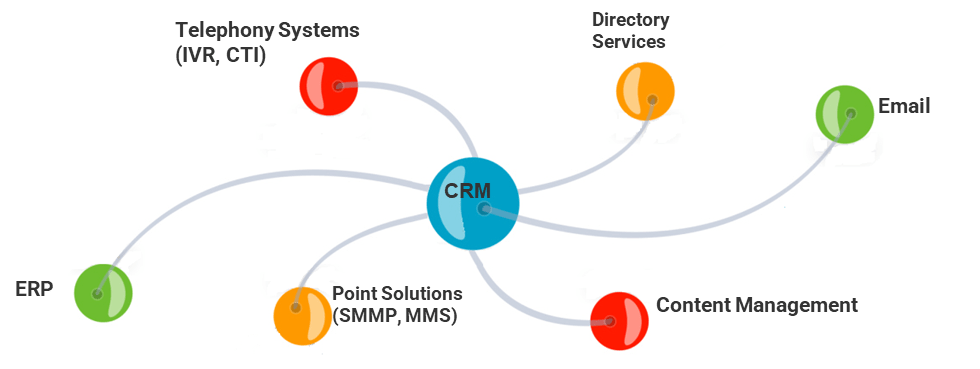
Integration is paramount: your CRM application often integrates with other applications within the organization. Create an integration map to reflect a system of record and the exchange of data. To increase customer engagement, channel integration is a must (i.e. with robust links to unified communications solutions, email, and VoIP telephony systems).
CRM plays a key role in the more holistic customer experience framework. However, it is heavily influenced by and often interacts with many other platforms.
Data is one key consideration that needs to be considered here. If customer information is fragmented, it will be nearly impossible to build a cohesive view of the customer. Points of integration (POIs) are the junctions between the CRM(s) and other applications where data is flowing to and from. They are essential to creating value, particularly in customer insight-focused and omnichannel-focused deployments.
Customer expectations are on the rise
CRM strategy is a critical component of customer experience (CX).
CUSTOMER EXPERIENCE
- Thoughtfulness is in
Connect with customers on a personal level - Service over products
The experience is more important than the product - Culture is now number one
Culture is the most overlooked piece of customer experience strategy - Engineering and service finally join forces
Companies are combining their technology and service efforts to create
strong feedback loops - The B2B world is inefficiently served
B2B needs to step up with more tools and a greater emphasis placed on
customer experience
Source: Forbes, 2019
Build a cohesive CRM strategy that aligns business goals with CRM capabilities.
Info-Tech Insight
Customers expect to interact with organizations through the channels of their choice. Now more than ever, you must enable your organization to provide tailored customer experiences.
IT is critical to the success of your CRM strategy
Today’s shared digital landscape of the CIO and CMO
CIO
- IT Operations
- Service Delivery and Management
- IT Support
- IT Systems and Application
- IT Strategy and Governance
- Cybersecurity
Collaboration and Partnership
- Digital Strategy = Transformation
Business Goals | Innovation | Leadership | Rationalization - Customer Experience
Architecture | Design | Omnichannel Delivery | Management - Insight (Market Facing)
Analytics | Business Intelligence | Machine Learning | AI - Marketing Integration + Operating Model
Apps | Channels | Experiences | Data | Command Center - Master Data
Customer | Audience | Industry | Digital Marketing Assets
CMO
- PEO Media
- Brand Management
- Campaign Management
- Marketing Tech
- Marketing Ops
- Privacy, Trust, and Regulatory Requirements
Info-Tech Insight
Technology is the key enabler of building strong customer experiences: IT must stand shoulder to shoulder with the business to develop a technology framework for customer relationship management.
Step 1.1
Identify Stakeholders and Build Your Optimization Team
Activities
1.1.1 Identify the stakeholders whose support will be critical to success
1.1.2 Select your CRM optimization team
Map Current-State Capabilities
This step will walk you through the following activities:
- Identify CRM drivers and objectives.
- Explore CRM challenges and pain points.
- Discover CRM benefits and opportunities.
- Align the CRM foundation with the corporate strategy.
This step involves the following participants:
- Stakeholders
- Project sponsors and leaders
Outcomes of this step
- Stakeholder map
- CRM optimization team composition
CRM optimization stakeholders
Understand the roles necessary to get the most out of your CRM.
Understand the role of each player within your optimization initiative. Look for listed participants on the activity slides to determine when each player should be involved.
Info-Tech Insight
Do not limit input or participation. Include subject matter experts and internal stakeholders at stages within the optimization initiative. Such inputs can be solicited on a one-off basis as needed. This ensures you take a holistic approach to creating your CRM optimization strategy.
| Title | Roles Within CRM Optimization Initiative |
|---|---|
Optimization Sponsor |
|
Optimization Initiative Manager |
|
Business Leads/ |
|
CRM Optimization Team |
|
Steering Committee |
|
1.1.1 Identify stakeholders critical to success
1 hour
- Hold a meeting to identify the stakeholders that should be included in the project’s steering committee.
- Finalize selection of steering committee members.
- Contact members to ensure their willingness to participate.
- Document the steering committee members and the milestone/presentation expectations for reporting project progress and results.
Input
- Stakeholder interviews
- Business process owners list
Output
- CRM optimization stakeholders
- Steering committee members
Materials
- N/A
Participants
- Product Owners
- CMO
- Departmental Leads – Sales, Marketing, Customer Service (and others)
- Applications Director
- Senior Business Analyst
- Senior Developer
- Procurement Analyst
The CRM optimization team
Consider the core team functions when composing the CRM optimization team. Form a cross-functional team (i.e. across IT, Marketing, Sales, Service, Operations) to create a well-aligned CRM optimization strategy.
Don’t let your core team become too large when trying to include all relevant stakeholders. Carefully limiting the size of the optimization team will enable effective decision making while still including functional business units such as Marketing, Sales, Service, and Customer Service.
Required Skills/Knowledge |
Suggested Optimization Team Members |
|---|---|
Business |
|
|
|
IT |
|
|
|
| Other | |
|
|
1.1.2 Select your CRM optimization team
30 minutes
- Have the CMO and other key stakeholders discuss and determine who will be involved in the CRM optimization project.
- Depending on the initiative and the size of the organization the size of the team will vary.
- Key business leaders in key areas – Sales, Marketing, Customer Service, and IT – should be involved.
- Document the members of your optimization team in the Get the Most Out of Your CRM Workbook, tab “1. Optimization Team.”
- Depending on your initiative and size of your organization, the size of this team will vary.
Get the Most Out of Your CRM Workbook
Input
- Stakeholders
Output
- List of CRM Optimization Team members
Materials
- Get the Most Out of Your CRM Workbook
Participants
- Product Owners
- CMO
- Departmental Leads – Sales, Marketing, Customer Service
- Applications Director
- Senior Business Analyst
- Senior Developer
- Procurement Analyst
Step 1.2
Build a CRM Strategy Model
Activities
- 1.2.1 Explore environmental factors and technology drivers
- 1.2.2 Discuss challenges and pain points
- 1.2.3 Discuss opportunities and benefits
- 1.2.4 Align CRM strategy with organizational goals
Map Current-State Capabilities
This step will walk you through the following activities:
- Identify CRM drivers and objectives.
- Explore CRM challenges and pain points.
- Discover the CRM benefits and opportunities.
- Align the CRM foundation with the corporate strategy.
This step involves the following participants:
- CRM Optimization Team
Outcomes of this step
- CRM business model
- Strategy alignment
Align the CRM strategy with the corporate strategy
Corporate Strategy
Your corporate strategy:
- Conveys the current state of the organization and the path it wants to take.
- Identifies future goals and business aspirations.
- Communicates the initiatives that are critical for getting the organization from its current state to the future state.
Unified Strategy
- The CRM optimization can be and should be linked, with metrics, to the corporate strategy and ultimate business objectives.
CRM Strategy
Your CRM Strategy:
- Communicates the organization’s budget and spending on CRM.
- Identifies IT initiatives that will support the business and key CRM objectives.
- Outlines staffing and resourcing for CRM initiatives.
CRM projects are more successful when the management team understands the strategic importance and the criticality of alignment. Time needs to be spent upfront aligning business strategies with CRM capabilities. Effective alignment between Sales, Marketing, Customer Service, Operations, IT, and the business should happen daily. Alignment doesn’t just need to occur at the executive level but at each level of the organization.
Sample CRM objectives
Increase Revenue |
Enable lead scoring |
Deploy sales collateral management tools |
Improve average cost per lead via a marketing automation tool |
|---|---|---|---|
Enhance Market Share |
Enhance targeting effectiveness with a CRM |
Increase social media presence via an SMMP |
Architect customer intelligence analysis |
Improve Customer Satisfaction |
Reduce time-to-resolution via better routing |
Increase accessibility to customer service with live chat |
Improve first contact resolution with customer KB |
Increase Customer Retention |
Use a loyalty management application |
Improve channel options for existing customers |
Use customer analytics to drive targeted offers |
Create Customer-Centric Culture |
Ensure strong training and user adoption programs |
Use CRM to provide 360-degree view of all customer interactions |
Incorporate the voice of the customer into product development |
Identifying organizational objectives of high priority will assist in breaking down business needs and CRM objectives. This exercise will better align the CRM systems with the overall corporate strategy and achieve buy-in from key stakeholders.
CRM business model Template
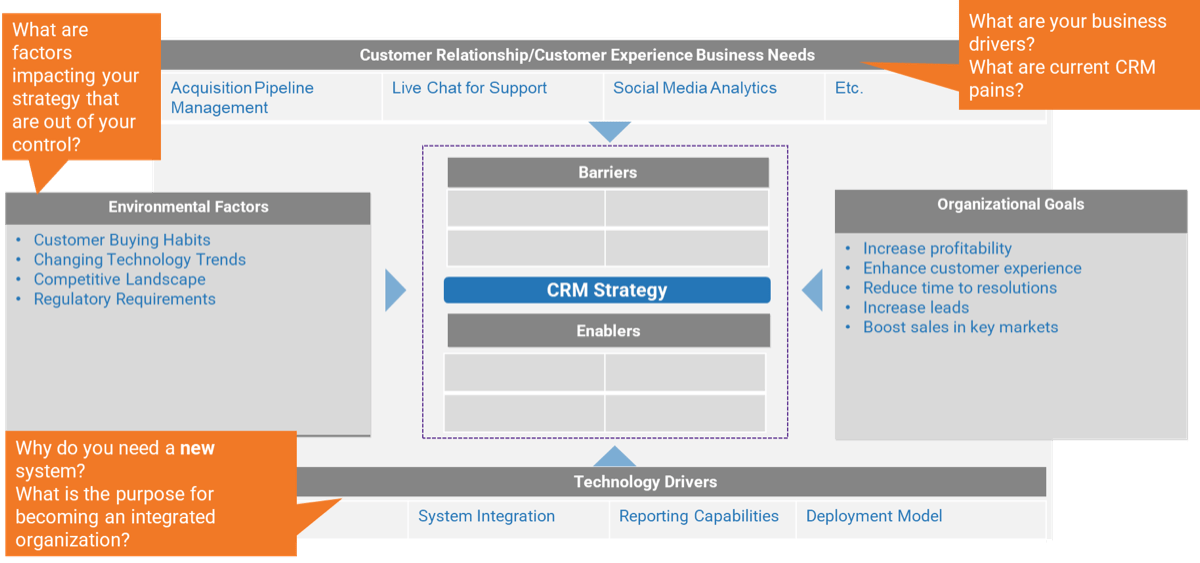
Understand objectives for creating a strong CRM strategy
Business Needs |
Business Drivers |
Technology Drivers |
Environmental Factors |
|
|---|---|---|---|---|
| Definition | A business need is a requirement associated with a particular business process. | Business drivers can be thought of as business-level goals. These are tangible benefits the business can measure such as employee retention, operation excellence, and financial performance. | Technology drivers are technological changes that have created the need for a new CRM enablement strategy. Many organizations turn to technology systems to help them obtain a competitive edge. | External considerations are factors taking place outside of the organization that are impacting the way business is conducted inside the organization. These are often outside the control of the business. |
Examples |
|
|
|
|
Info-Tech Insight
One of the biggest drivers for CRM adoption is the ability to make decisions through consolidated data. This driver is a result of external considerations. Many industries today are highly competitive, uncertain, and rapidly changing. To succeed under these pressures, there needs to be timely information and visibility into all components of the organization.
1.2.1 Explore environmental factors and technology drivers
30 minutes
- Identify business drivers that are contributing to the organization’s need for CRM.
- Understand how the company is running today and what the organization’s future will look like. Try to identify the purpose for becoming an integrated organization. Use a whiteboard and markers to capture key findings.
- Consider environmental factors: external considerations, organizational drivers, technology drivers, and key functional requirements.
- Use the Get the Most Out of Your CRM Workbook, tab “2. Business Model,” to complete this exercise.
Get the Most Out of Your CRM Workbook
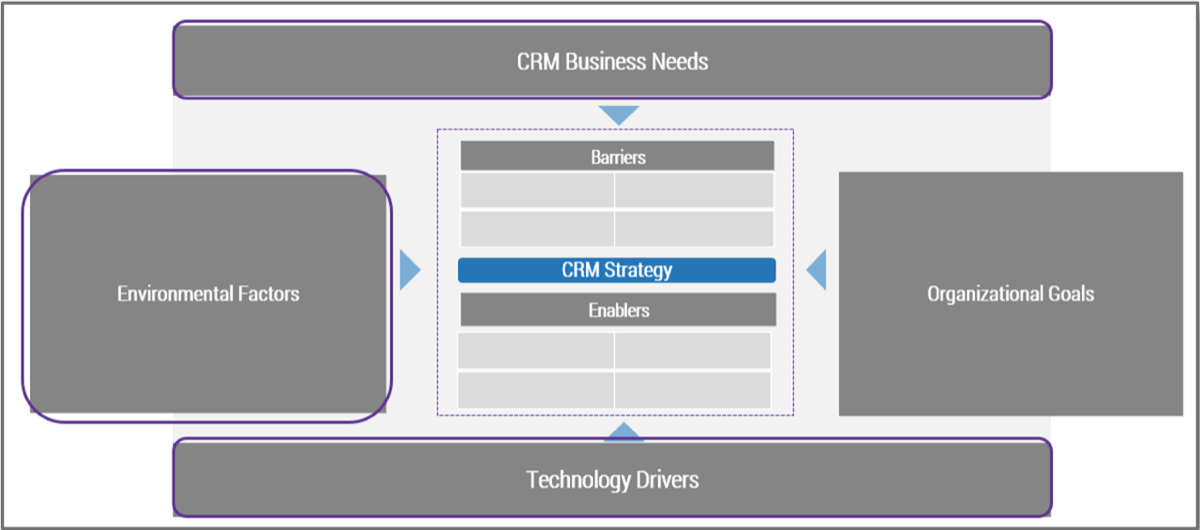 |
|||
|---|---|---|---|
External Considerations |
Organizational Drivers |
Technology Considerations |
Functional Requirements |
|
|
|
|
Create a realistic CRM foundation by identifying the challenges and barriers to the project
There are several different factors that may stifle the success of an CRM portfolio. Organizations creating an CRM foundation must scan their current environment to identify internal barriers and challenges.
Common Internal Barriers
Management Support |
Organizational Culture |
Organizational Structure |
IT Readiness |
|
|---|---|---|---|---|
| Definition | The degree of understanding and acceptance towards CRM technology and systems. | The collective shared values and beliefs. | The functional relationships between people and departments in an organization. | The degree to which the organization’s people and processes are prepared for new CRM system(s.) |
Questions |
|
|
|
|
| Impact |
|
|
|
|
1.2.2 Discuss challenges and pain points
30 minutes
- Identify challenges with current systems and processes.
- Brainstorm potential barriers to success. Use a whiteboard and markers to capture key findings.
- Consider the project barriers: functional gaps, technical gaps, process gaps, and barriers to CRM success.
- Use the Get the Most Out of Your CRM Workbook, tab “2. Business Model,” to complete this exercise.
Get the Most Out of Your CRM Workbook
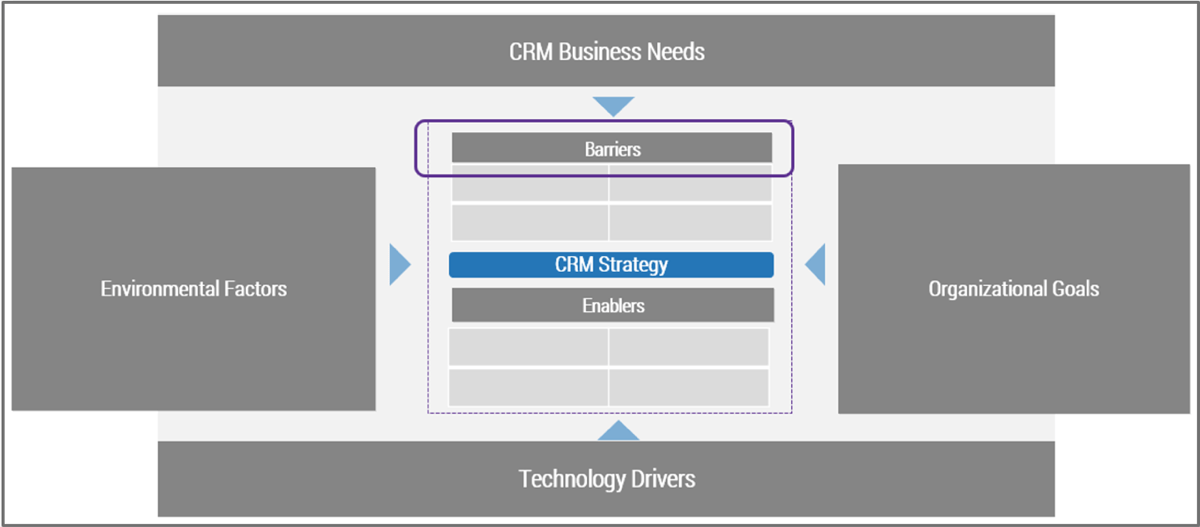 |
|||
|---|---|---|---|
Functional Gaps |
Technical Gaps |
Process Gaps |
Barriers to Success |
|
|
|
|
1.2.3 Discuss opportunities and benefits
30 minutes
- Identify opportunities and benefits from an integrated system.
- Brainstorm potential enablers for successful CRM enablement and the ideal portfolio.
- Consider the project enablers: business benefits, IT benefits, organizational benefits, and enablers of CRM success.
- Use the Get the Most Out of Your CRM Workbook, tab “2. Business Model,” to complete this exercise.
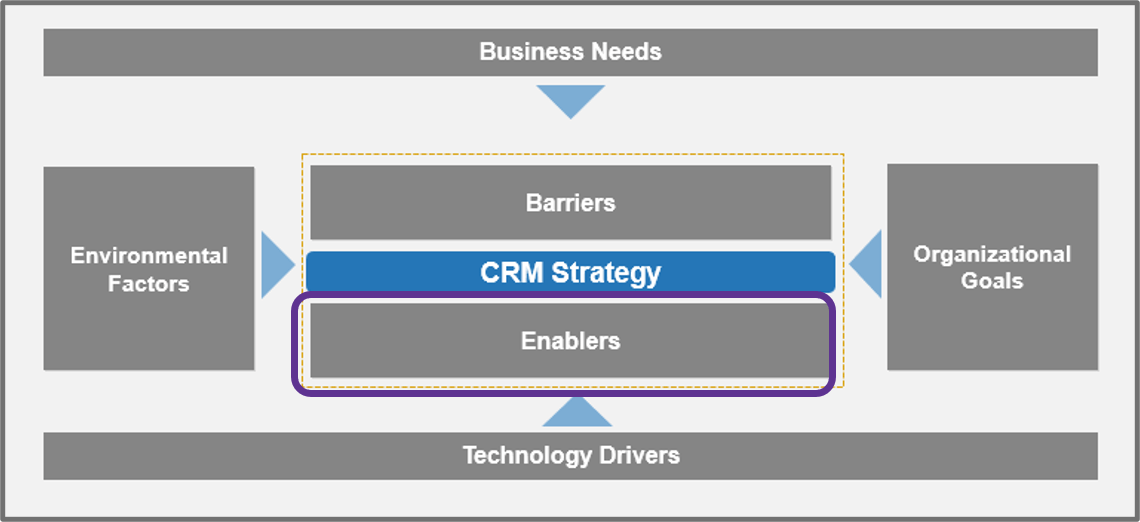 | |||
|---|---|---|---|
Business Benefits | IT Benefits | Organizational Benefits | Enablers of Success |
|
|
|
|
1.2.4 Align CRM strategy with organizational goals
1 hour
- Discuss your corporate objectives (organizational goals). Choose three to five corporate objectives that are a priority for the organization in the current year.
- Break into groups and assign each group one corporate objective.
- For each objective, produce several ways an optimized CRM system will meet the given objective.
- Think about the modules and CRM functions that will help you realize these benefits.
- Use the Get the Most Out of Your CRM Workbook, tab “2. Business Model,” to complete this exercise.
| Increase Revenue | CRM Benefits |
|---|---|
|
|
|
|
|
|
|
Input
- Organizational goals
- CRM strategy model
Output
- Optimization benefits map
Materials
- Get the Most Out of Your CRM Workbook
Participants
- Product Owners
- CMO
- Departmental Leads – Sales, Marketing, Customer Service
- Applications Director
- Senior Business Analyst
- Senior Developer
- Procurement Analyst
Download the Get the Most Out of Your CRM Workbook
Step 1.3
Inventory Current System State
Activities
1.3.1 Inventory applications and interactions
Map Current-State Capabilities
This step will walk you through the following activities:
- Inventory applications
- Map interactions between systems
This step involves the following participants:
- CRM Optimization Team
- Enterprise Architect
- Data Architect
Outcomes of this step
- Systems inventory
- Systems diagram
1.3.1 Inventory applications and interactions
1-3 hours
- Individually list all electronic systems involved in the organization. This includes anything related to customer information and interactions, such as CRM, ERP, e-commerce, finance, email marketing, and social media, etc.
- Document data flows into and out of each system to the ERP. Refer to the example on the next slide (CRM data flow).
- Review the processes in place (e.g. reporting, marketing, data moving into and out of systems). Document manual processes. Identify integration points. If flowcharts exist for these processes, it may be useful to provide these to the participants.
- If possible, diagram the system. Include information direction flow. Use the sample CRM map, if needed.
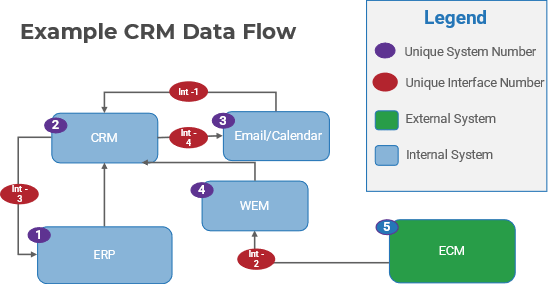
CRM data flow

Be sure to include enterprise applications that are not included in the CRM application portfolio. Popular systems to consider for POIs include billing, directory services, content management, and collaboration tools.
When assessing the current application portfolio that supports CRM, the tendency will be to focus on the applications under the CRM umbrella, relating mostly to Marketing, Sales, and Customer Service. Be sure to include systems that act as input to, or benefit due to outputs from, the CRM or similar applications.
Sample CRM map
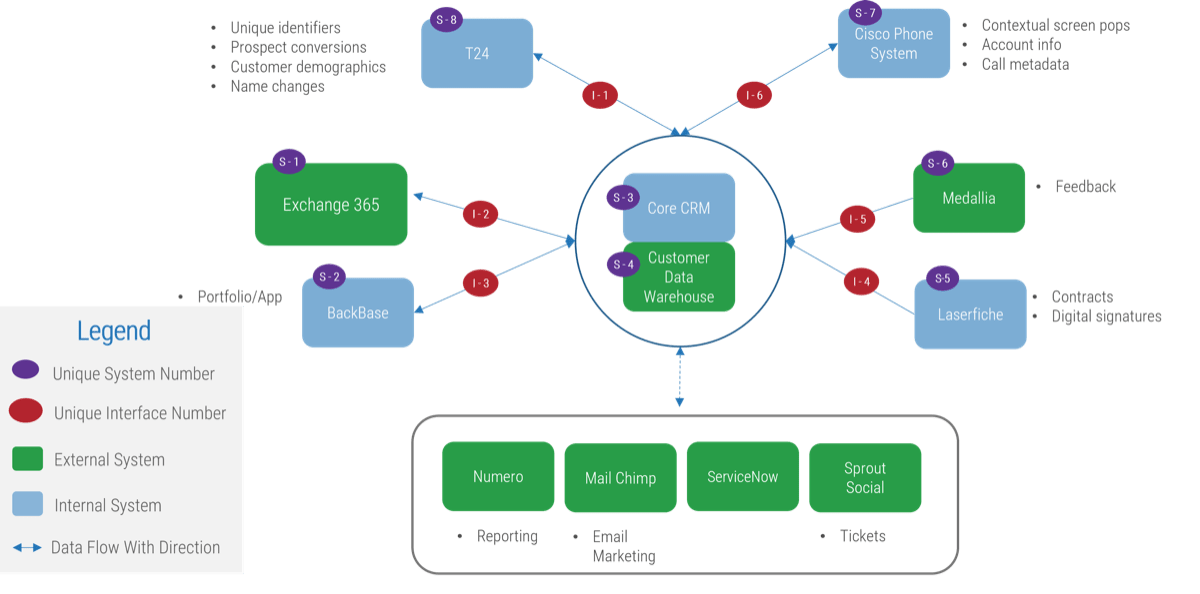
Step 1.4
Define Business Capabilities
Activities
1.4.1 Define business capabilities
1.4.2 List your key CRM processes
Map Current-State Capabilities
This step will walk you through the following activities:
- Define your business capabilities
- List your key CRM processes
This step involves the following participants:
- CRM Optimization Team
- Business Architect
Outcomes of this step
- Business capabilities map
- Key CRM processes list
Business capability map (Level 0)
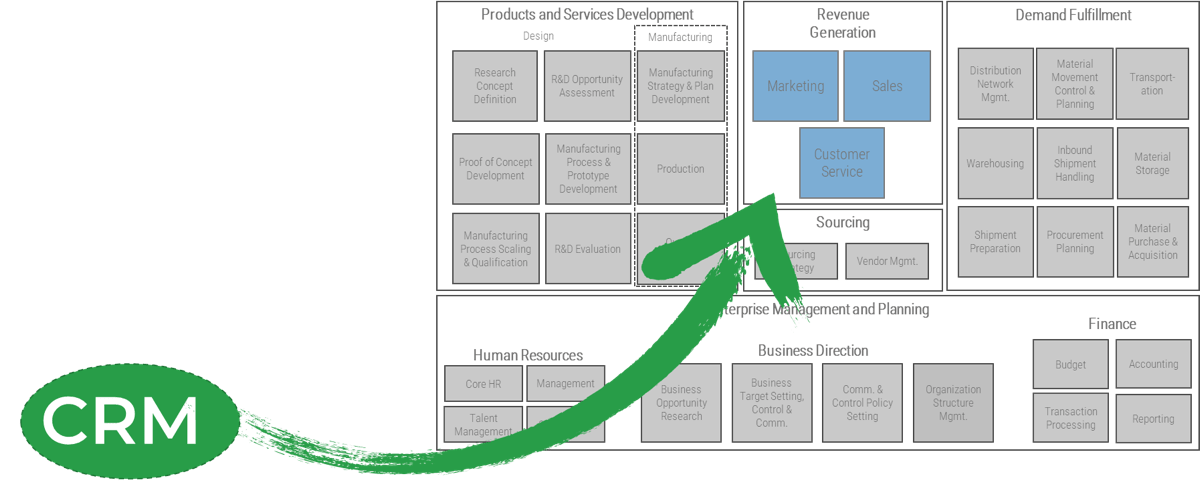
In business architecture, the primary view of an organization is known as a business capability map.
A business capability defines what a business does to enable value creation, rather than how.
Business capabilities:
- Represent stable business functions.
- Are unique and independent of each other.
- Typically will have a defined business outcome.
A business capability map provides details that help the business architecture practitioner direct attention to a specific area of the business for further assessment.
Capability vs. process vs. feature
Understanding the difference
When examining CRM optimization, it is important we approach this from the appropriate layer.
Capability:
- The ability of an entity (e.g. organization or department) to achieve its objectives (APQC, 2017).
- An ability that an organization, person, or system possesses. Typically expressed in general and high-level terms and typically require a combination of organization, people, processes, and technology to achieve (TOGAF).
Process:
- Can be manual or technology enabled. A process is a series of interrelated activities that convert inputs into results (outputs). Processes consume resources, require standards for repeatable performance, and respond to control systems that direct the quality, rate, and cost of performance. The same process can be highly effective in one circumstance and poorly effective in another with different systems, tools, knowledge, and people (APQC, 2017).
Feature:
- Is a distinguishing characteristic of a software item (e.g. performance, portability, or functionality) (IEEE, 2005).
In today’s complex organizations, it can be difficult to understand where inefficiencies stem from and how performance can be enhanced.
To fix problems and maximize efficiencies business capabilities and processes need to be examined to determine gaps and areas of lagging performance.
Info-Tech’s CRM framework and industry tools such as the APQC’s Process Classification Framework can help make sense of this.
1.4.1 Define business capabilities
1-3 hours
- Look at the major functions or processes within the scope of CRM.
- Compile an inventory of current systems that interact with the chosen processes. In its simplest form, document your application inventory in a spreadsheet (see tab 3 of the CRM Application Inventory Tool). For large organizations, interview representatives of business domains to help create your list of applications.
- Make sure to include any processes that are manual versus automated.
- Use your current state drawing from activity 1.3.1 to link processes to applications for further effect.
CRM Application Inventory Tool
Input
- Current systems
- Key processes
- APQC Framework
- Organizational process map
Output
- List of key business processes
Materials
- CRM Application Inventory Tool
- CRM APQC Framework
- Whiteboard, PowerPoint, or flip charts
- Pens/markers
Participants
- CRM Optimization Team
CRM process mapping
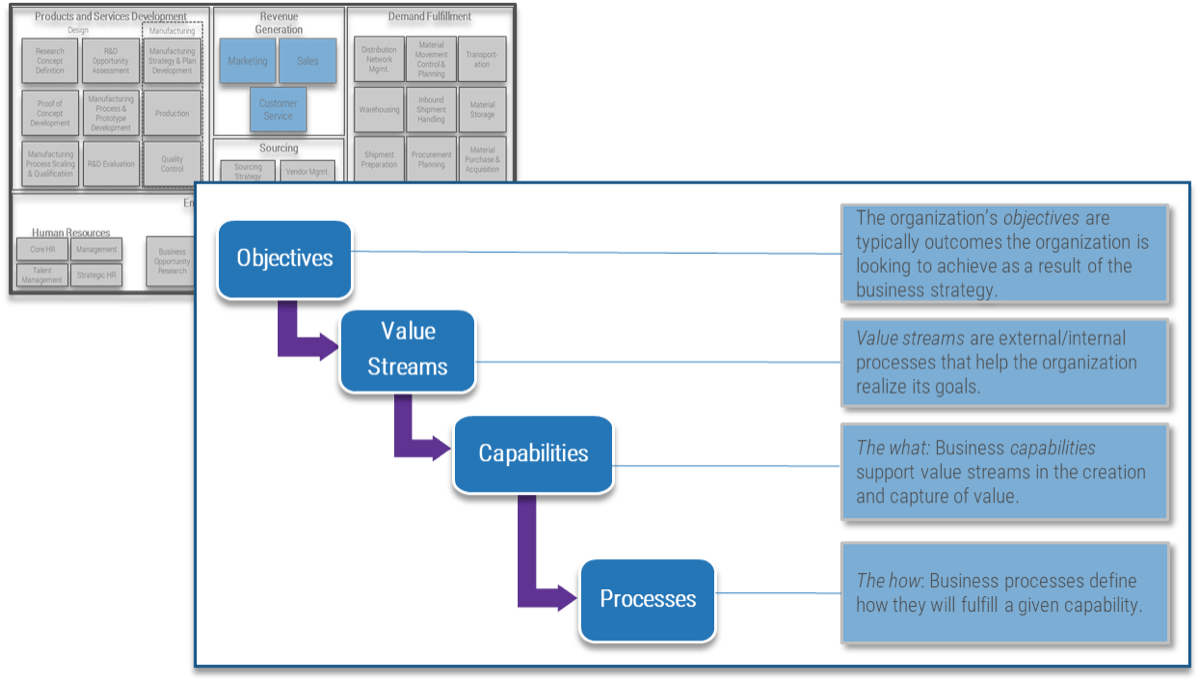
The operating model
An operating model is a framework that drives operating decisions. It helps to set the parameters for the scope of CRM and the processes that will be supported. The operating model will serve to group core operational processes. These groupings represent a set of interrelated, consecutive processes aimed at generating a common output.
The Value Stream
Value Stream Defined
Value Streams |
Design Product |
Produce Product |
Sell Product |
Customer Service |
|---|---|---|---|---|
|
|
|
|
Value streams connect business goals to the organization’s value realization activities in the marketplace. Those activities are dependent on the specific industry segment in which an organization operates.
There are two types of value streams: core value streams and support value streams.
- Core value streams are mostly externally facing. They deliver value to either an external or internal customer and they tie to the customer perspective of the strategy map.
- Support value streams are internally facing and provide the foundational support for an organization to operate.
An effective method for ensuring all value streams have been considered is to understand that there can be different end-value receivers.
APQC Framework
Help define your inventory of sales, marketing, and customer services processes.
Operating Processes
- Develop Vision and Strategy
- Develop and Manage Products and Services
- Market and Sell Products and Services
- Deliver Physical Products
- Deliver Services
Management and Support Processes
- Manage Customer Service
- Develop and Manage Human Capital
- Manage Information Technology (IT)
- Manage Financial Resources
- Acquire, Construct, and Manage Assets
- Manage Enterprise Risk, Compliance, Remediation, and Resiliency
- Manage External Relationships
- Develop and Manage Business Capabilities
Source: APQC, 2020
If you do not have a documented process model, you can use the APQC Framework to help define your inventory of sales business processes.
APQC’s Process Classification Framework is a taxonomy of cross-functional business processes intended to allow the objective comparison of organizational performance within and among organizations.
Process mapping hierarchy
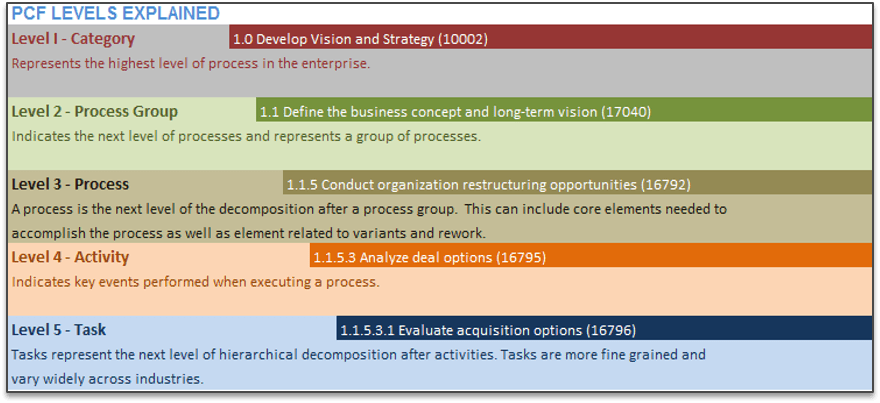
APQC provides a process classification framework. It allows organizations to effectively define their processes and manage them appropriately.
THE APQC PROCESS CLASSIFICATION FRAMEWORK (PCF)® was developed by non-profit APQC, a global resource for benchmarking and best practices, and its member companies as an open standard to facilitate improvement through process management and benchmarking, regardless of industry, size, or geography. The PCF organizes operating and management processes into 12 enterprise level categories, including process groups and over 1,000 processes and associated activities. To download the full PCF or industry-specific versions of the PCF as well as associated measures and benchmarking, visit www.apqc.org/pcf.
Cross-industry classification framework
| Level 1 | Level | Level 3 | Level 4 |
|---|---|---|---|
Market and sell products and services |
Understand markets, customers, and capabilities | Perform customer and market intelligence analysis | Conduct customer and market research |
Market and sell products and services |
Develop sales strategy | Develop sales forecast | Gather current and historic order information |
Deliver services |
Manage service delivery resources | Manage service delivery resource demand | Develop baseline forecasts |
| ? | ? | ? | ? |
Info-Tech Insight
Focus your initial assessment on the level 1 processes that matter to your organization. This allows you to target your scant resources on the areas of optimization that matter most to the organization and minimize the effort required from your business partners.
You may need to iterate the assessment as challenges are identified. This allows you to be adaptive and deal with emerging issues more readily and become a more responsive partner to the business.
1.4.2 List your key CRM processes
1-3 hours
- Reflect on your organization’s CRM capabilities and processes.
- Refer to tab 4, “Process Importance,” in your Get the Most Out of Your CRM Workbook. You can use your own processes if you prefer. Consult tab 10. “Framework (Reference)” in the Workbook to explore additional capabilities.
- Use your CRM goals as a guide.
Get the Most Out of Your CRM Workbook
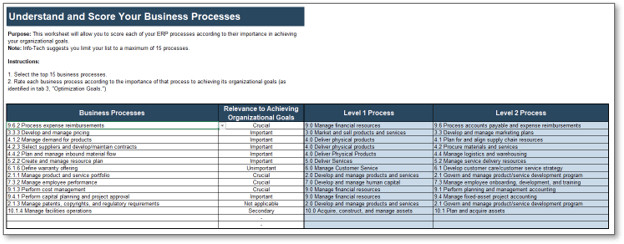
*Adapted from the APQC Cross-Industry Process Classification Framework, 2019.
Step 1.5
Understand CRM Costs
Activities
1.5.1 List CRM-related costs (optional)
Map Current-State Capabilities
This step will walk you through the following activities:
- Define your business capabilities
- List your key CRM processes
This step involves the following participants:
- Finance Representatives
- CRM Optimization Team
Outcomes of this step
- Current CRM and related operating costs
1.5.1 List CRM-related costs (optional)
3+ hours
Before you can make changes and optimization decisions, you need to understand the high-level costs associated with your current application architecture. This activity will help you identify the types of technology and people costs associated with your current systems.
- Identify the types of technology costs associated with each current system:
- System Maintenance
- Annual Renewal
- Licensing
- Identify the cost of people associated with each current system:
- Full-Time Employees
- Application Support Staff
- Help Desk Tickets
- Use the Get the Most Out of Your CRM Workbook, tab “9. Costs (Optional),” to complete this exercise.
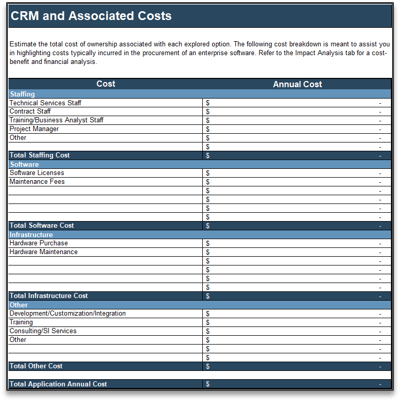
Get the Most Out of Your CRM Workbook
Phase 2
Assess Your Current State
- 2.1 Conduct a Gap Analysis for CRM Processes
- 2.2 Assess User Satisfaction
- 2.3 Review Your Satisfaction With the Vendor and Product
Get the Most Out of Your CRM
This phase will guide you through the following activities:
- Determine process relevance
- Perform a gap analysis
- Perform a user satisfaction survey
- Assess software and vendor satisfaction
This phase involves the following participants:
- CRM optimization team
- Users across functional areas of your CRM and related technologies
Step 2.1
Conduct a Gap Analysis for CRM Processes
Activities
- 2.1.1 Determine process relevance
- 2.1.2 Perform process gap analysis
Assess Your Current State
This step will walk you through the following activities:
- Determine process relevance
- Perform a gap analysis
This step involves the following participants:
- CRM optimization team
Outcomes of this step
- Gap analysis for CRM-related processes (current vs. desired state)
2.1.1 Determine process relevance
1-3 hours
- Open tab “4. Process Importance,” in the Get the Most Out of Your CRM Workbook.
- Rate each process for level of importance to your organization on the following scale:
- Crucial
- Important
- Secondary
- Unimportant
- Not applicable
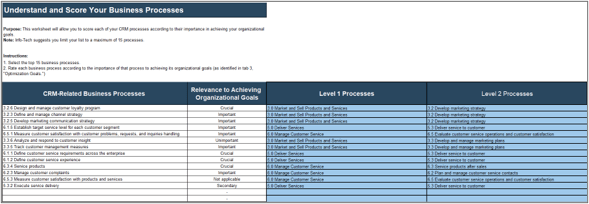
2.1.2 Perform process gap analysis
1-3 hours
- Open tab “5. Process Assessment,” in the Get the Most Out of Your CRM Workbook.
- For each line item, identify your current state and your desired state on the following scale:
- Not important
- Poor
- Moderate
- Good
- Excellent
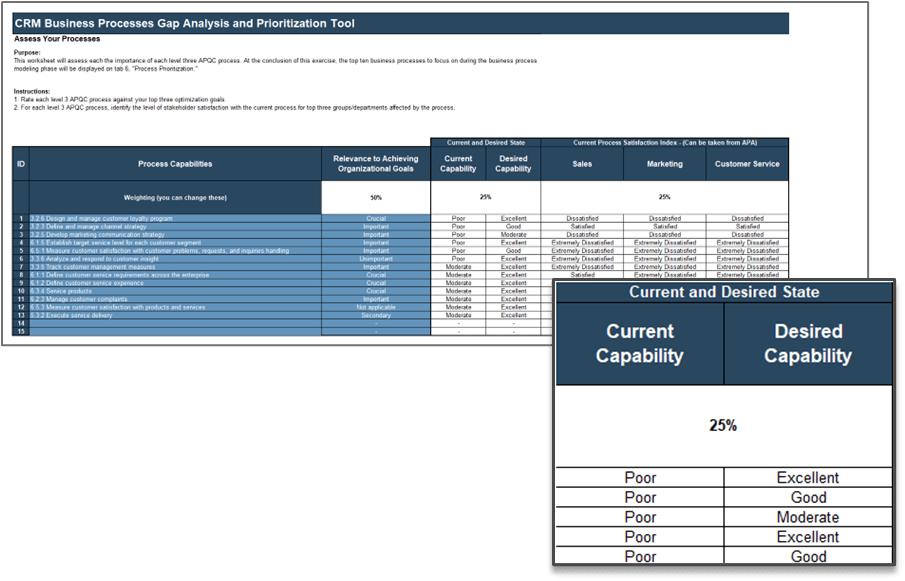
Step 2.2
Assess User Satisfaction
Activities
- 2.2.1 Prepare and complete a user satisfaction survey
- 2.2.2 Enter user satisfaction
Assess Your Current State
This step will walk you through the following activities:
- Preparation and completion of an application portfolio assessment (APA)
- Entry of the user satisfaction scores into the workbook
This step involves the following participants:
- CRM optimization team
- Users across functional areas of CRM and related technologies
Outcomes of this step
- Understanding of user satisfaction across applications and processes
- Insight into CRM data quality
Benefits of the Application Portfolio Assessment
Assess the health of the application portfolio
- Get a full 360-degree view of the effectiveness, criticality, and prevalence of all relevant applications to get a comprehensive view of the health of the applications portfolio.
- Identify opportunities to drive more value from effective applications, retire nonessential applications, and immediately address at-risk applications that are not meeting expectations.
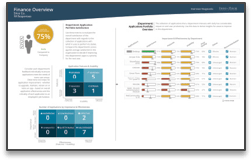
Provide targeted department feedback
- Share end-user satisfaction and importance ratings for core IT services, IT communications, and business enablement to focus on the right end-user groups or lines of business, and ramp up satisfaction and productivity.
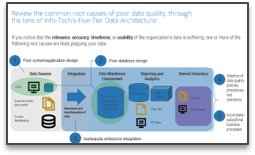
Insight into the state of data quality
- Data quality is one of the key issues causing poor CRM user satisfaction and business results. This can include the relevance, accuracy, timeliness, or usability of the organization’s data.
- Targeted, open-ended feedback around data quality will provide insight into where optimization efforts should be focused.
2.2.1 Prepare and complete a user satisfaction survey
1 hour
Option 1: Use Info-Tech’s Application Portfolio Assessment to generate your user satisfaction score. This tool not only measures application satisfaction but also elicits great feedback from users regarding support they receive from the IT team.
- Download the CRM Application Inventory Tool.
- Complete the “Demographics” tab (tab 2).
- Complete the “Inventory” tab (tab 3).
- Complete the inventory by treating each process within the organization as a separate row. Use the processes identified in the process gap analysis as a reference.
- Treat every department as a separate column in the department section. Feel free to add, remove, or modify department names to match your organization.
- Include data quality for all applications applicable.
Option 2: Use the method of choice to elicit current user satisfaction for each of the processes identified as important to the organization.
- List processes identified as important (from the Get the Most Out of Your CRM Workbook, tab 4, “Process Importance”).
- Gather user contact information by department.
- Ask users to rate satisfaction: Extremely Satisfied, Satisfied, Neutral, Dissatisfied, and Extremely Dissatisfied (on Get the Most Out of Your CRM Workbook, tab 5. “Process Assessment”).
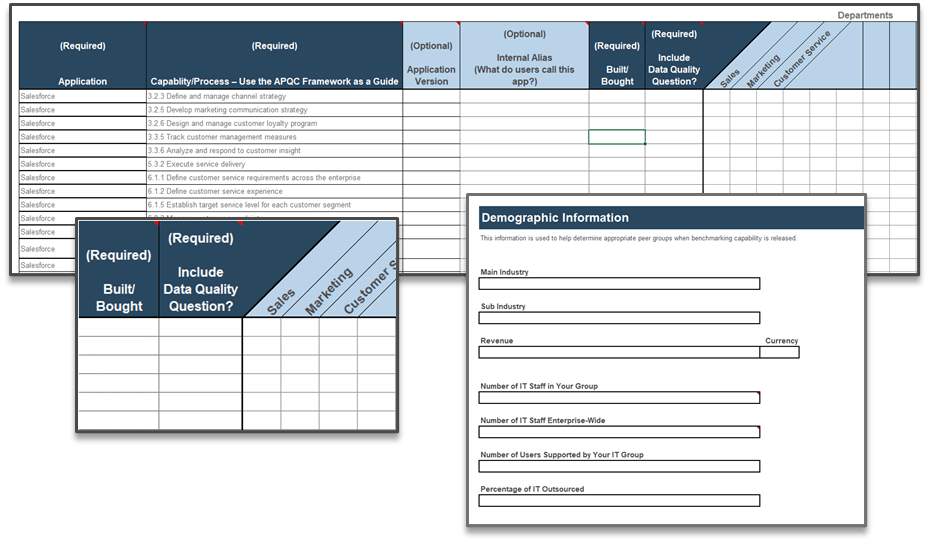
Understand user satisfaction across capabilities and departments within your organization.
Download the CRM Application Inventory Tool
2.2.2 Enter user satisfaction
20 minutes
Using the results from the Application Portfolio Assessment or your own user survey:
- Open your Get the Most Out of Your CRM Workbook, tab “5. Process Assessment.”
- For each process, record up to three different department responses.
- Enter the answers to the survey for each line item using the drop-down options:
- Extremely Satisfied
- Satisfied
- Neutral
- Dissatisfied
- Extremely Dissatisfied
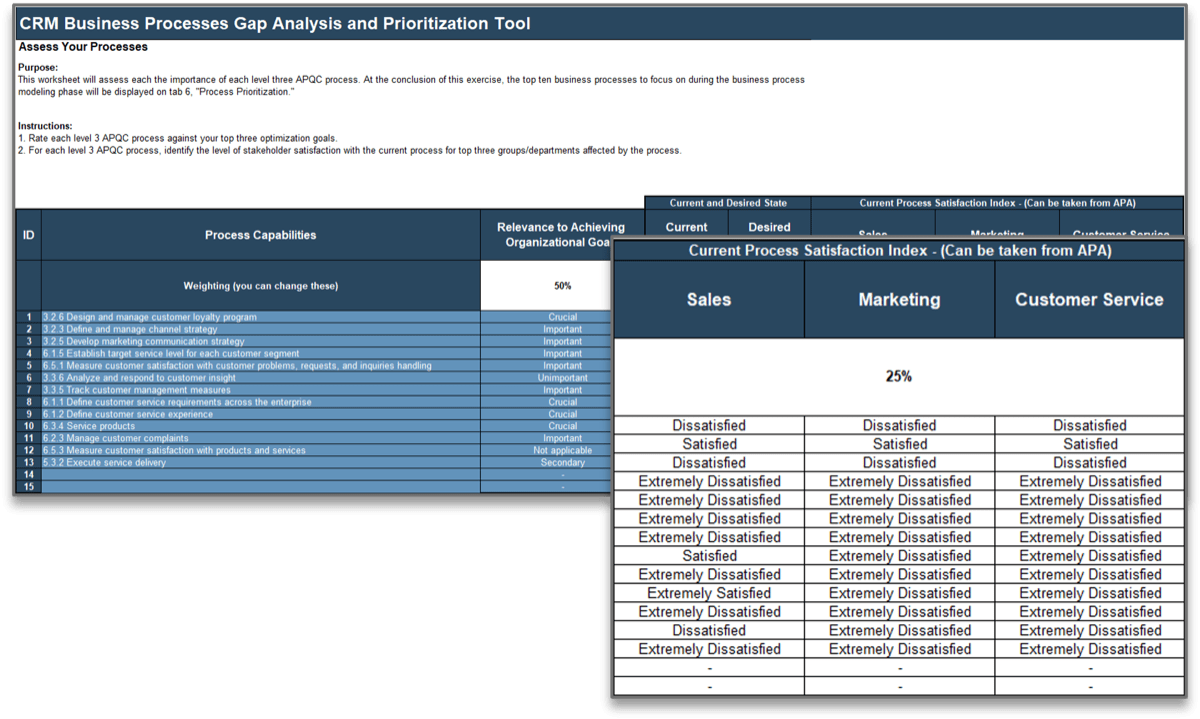
Understand user satisfaction across capabilities and departments within your organization.
Step 2.3
Review Your Satisfaction With the Vendor and Product
Activities
2.3.1 Rate your vendor and product satisfaction
2.3.2 Enter SoftwareReviews scores from your CRM Product Scorecard (optional)
Assess Your Current State
This step will walk you through the following activities:
- Rate your vendor and product satisfaction
- Compare with survey data from SoftwareReviews
This step involves the following participants:
- CRM Owner(s)
- Procurement Representative
- Vendor Contracts Manager
Outcomes of this step
- Quantified satisfaction with vendor and product
Use a SoftwareReviews Product Scorecard to evaluate your satisfaction compared to other organizations.
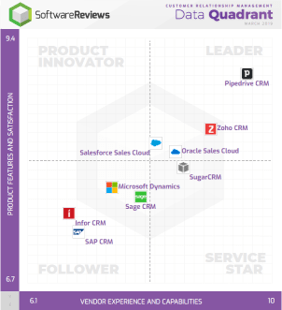
Source: SoftwareReviews, March 2019
Where effective IT leaders spend their time
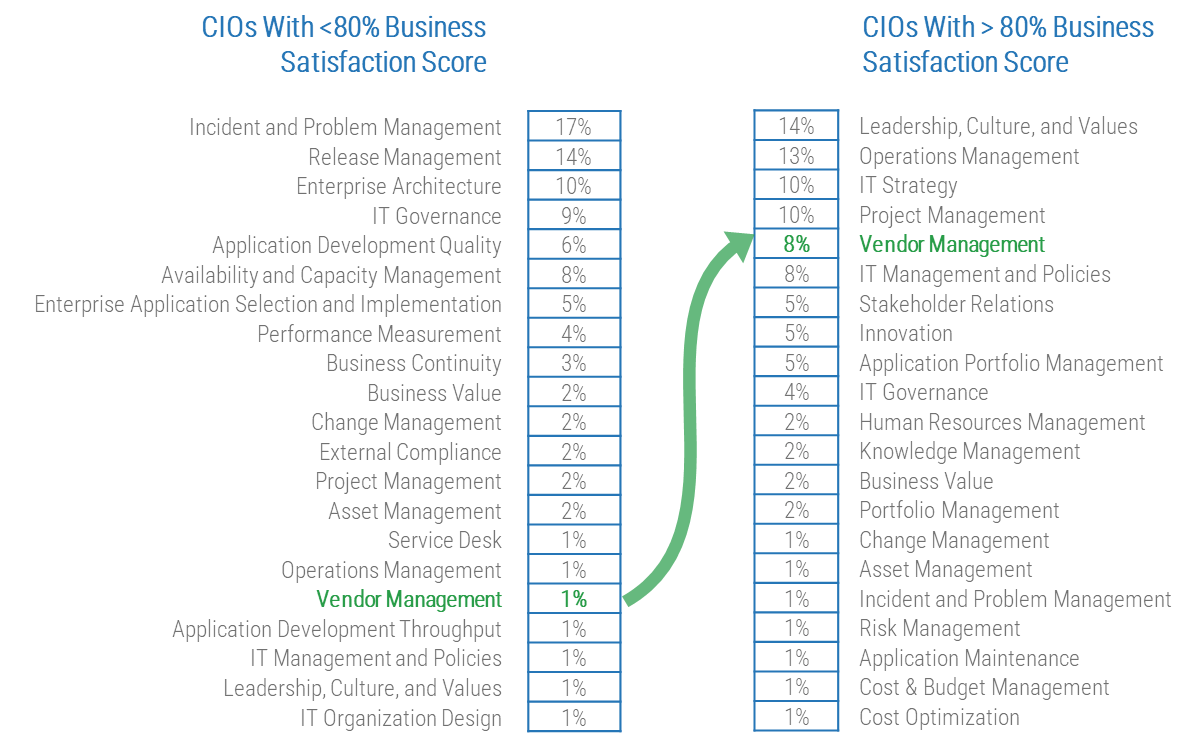 80% satisfaction score, and the other list is CIOs with <80% satisfaction score.">
80% satisfaction score, and the other list is CIOs with <80% satisfaction score.">
Info-Tech Insight
The data shows that effective IT leaders invest a significant amount of time (8%) on vendor management initiatives.
Be proactive in managing you calendar and block time for these important tasks.
CIOs who prioritize vendor management see improved results
Analysis of CIOs’ calendars revealed that how CIOs spend their time has a correlation to both stakeholder IT satisfaction and CEO-CIO alignment.
Those CIOs that prioritized vendor management were more likely to have a business satisfaction score greater than 80%.
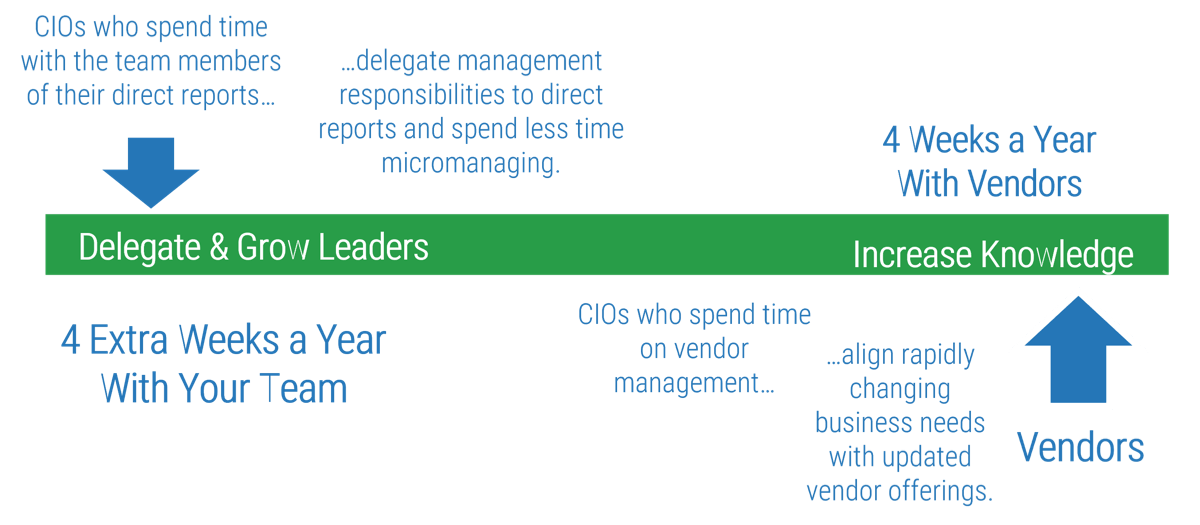
2.3.1 Rate your vendor and product satisfaction
30 minutes
Use Info-Tech’s vendor satisfaction survey to identify optimization areas with your CRM product(s) and vendor(s).
Option 1 (recommended): Conduct a satisfaction survey using SoftwareReviews. This option allows you to see your results in the context of the vendor landscape.
Download the Get the Most Out of Your CRM Workbook
Option 2: Use your Get the Most Out of Your CRM Workbook, tab “6. Vendor Optimization,” to review your satisfaction with your software.
SoftwareReviews’ Customer Relationship Management
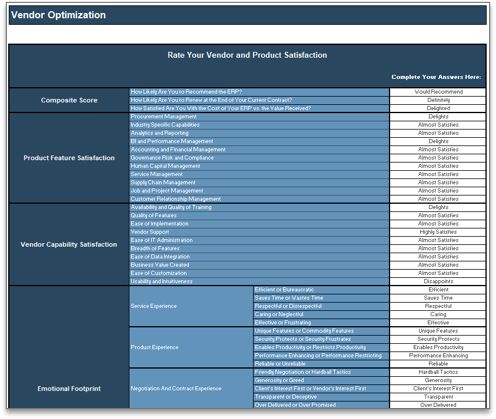
2.3.2 Enter SoftwareReviews scores (optional)
30 minutes
- Download the scorecard for your CRM product from the SoftwareReviews website. (Note: Not all products are represented or have sufficient data, so a scorecard may not be available.)
- Use your Get the Most Out of Your CRM Workbook, tab “6. Vendor Optimization,” to record the scorecard results.
- Use your Get the Most Out of Your CRM Workbook, tab “6. Vendor Optimization,” to flag areas where your score may be lower than the product scorecard. Brainstorm ideas for optimization.
Download the Get the Most Out of Your CRM Workbook
SoftwareReviews’ Customer Relationship Management
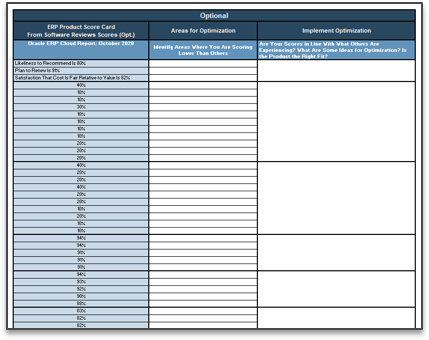
Phase 3
Build Your Optimization Roadmap
- 3.1 Identify Key Optimization Areas
- 3.2 Compile Optimization Assessment Results
Get the Most Out of Your CRM
This phase will walk you through the following activities:
- Identify key optimization areas
- Create an optimization roadmap
This phase involves the following participants:
- CRM Optimization Team
Build your optimization roadmap
Address process gaps
- CRM and related technologies are invaluable to sales, marketing, and customer service enablement, but they must have supported processes driven by business goals.
- Identify areas where capabilities need to be improved and work towards.
Support user satisfaction
- The best technology in the world won’t deliver business results if it is not working for the users who need it.
- Understand concerns, communicate improvements, and support users in all roles.
Improve data quality
- Data quality is unique to each business unit and requires tolerance, not perfection.
- Implement a set of data quality initiatives that are aligned with overall business objectives and aimed at addressing data practices and the data itself.
Proactively manage vendors
- Vendor management is a critical component of technology enablement and IT satisfaction.
- Assess your current satisfaction against those of your peers and work towards building a process that is best fit for your organization.
Info-Tech Insight
Enabling a high-performing, customer-centric sales, marketing, and customer service operations program requires excellent management practices and continuous optimization efforts.
Technology portfolio and architecture is important, but we must go deeper. Taking a holistic view of CRM technologies in the environments in which they operate allows for the inclusion of people and process improvements – this is key to maximizing business results.
Using a formal CRM optimization initiative will drive business-IT alignment, identify IT automation priorities, and dig deep into continuous process improvement.
Step 3.1
Identify Key Optimization Areas
Activities
- 3.1.1 Explore process gaps
- 3.1.2 Analyze user satisfaction
- 3.1.3 Assess data quality
- 3.1.4 Analyze product satisfaction and vendor management
Build Your Optimization Roadmap
This step will guide you through the following activities:
- Explore existing process gaps
- Identify the impact of processes on user satisfaction
- Identify the impact of data quality on user satisfaction
- Review your overall product satisfaction and vendor management
This step involves the following participants:
- CRM Optimization Team
Outcomes of this step
- Application optimization plan
3.1.1 Explore process gaps
1 hour
- Review the compiled CRM Process Assessment in the Get the Most Out of Your CRM Workbook, tab “7. Process Prioritization.”
- These are processes you should prioritize.
- The activities in the rest of Step 3.1 help you create optimization strategies for the different areas of improvement these processes relate to: user satisfaction, data quality, product satisfaction, and vendor management.
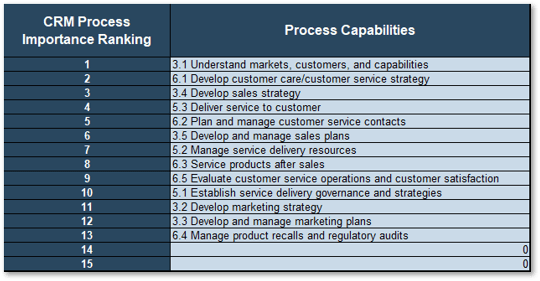
Plan your product optimization strategy for each area of improvement
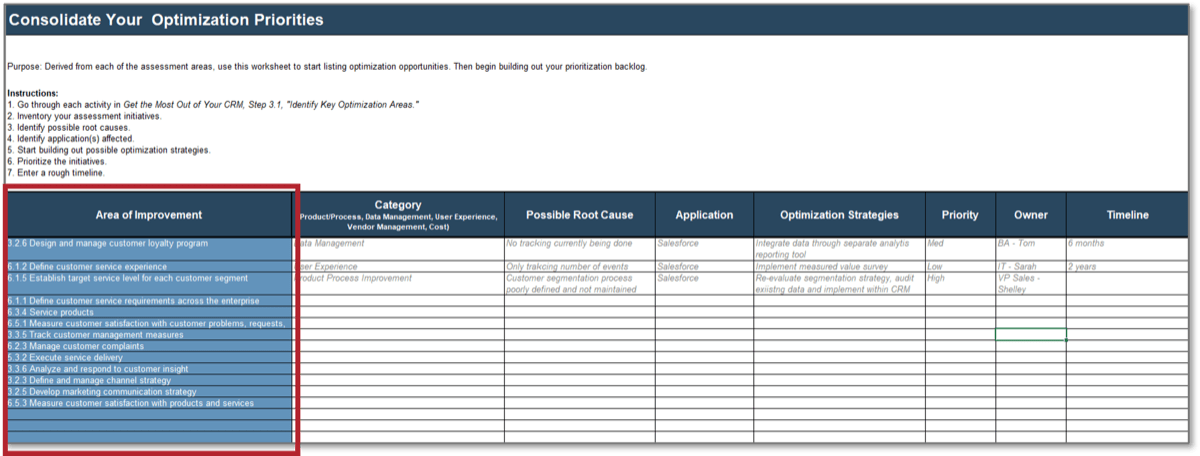
3.1.2 Analyze user satisfaction
1 hour
- Use the APA survey results from activity 2.2.1 (or your own internal survey) to identify areas where the organization is performing low in user satisfaction across the CRM portfolio.
- Understand application portfolio and IT service satisfaction.
- Identify cost savings opportunities from unused or unimportant apps.
- Build a roadmap for improving user IT services.
- Manage needs by department and seniority.
- Consolidate your optimization strategies in the Get the Most Out of Your CRM Workbook, tab “8. Optimization Roadmap.” (See next slide for screenshot.)
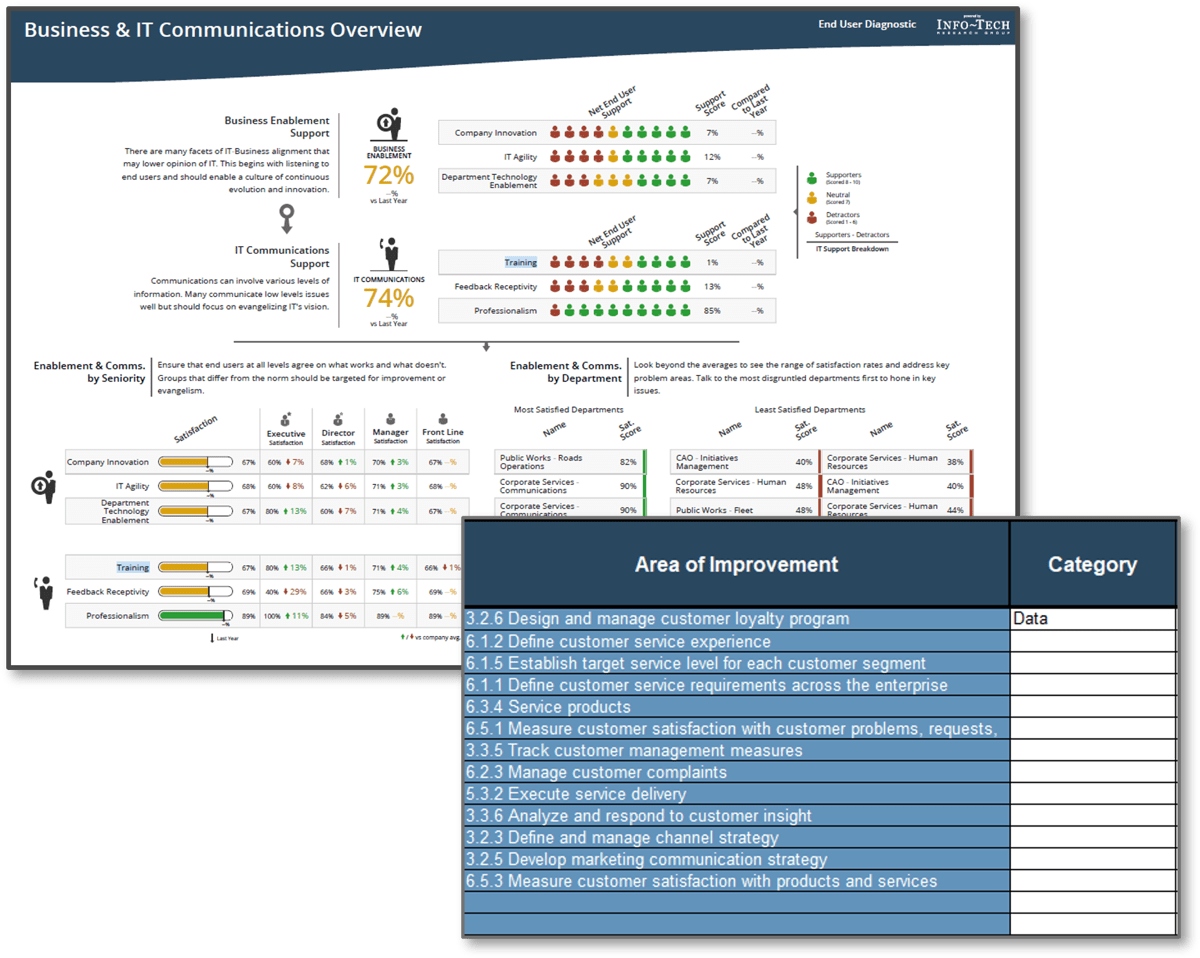
Plan your user satisfaction optimization strategy
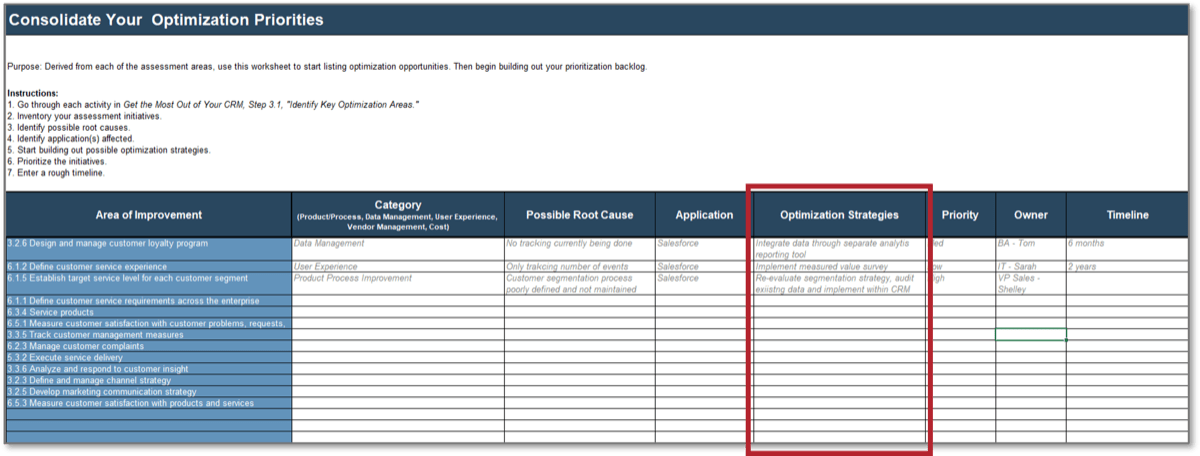
Next steps in improving your data quality
| Data Quality Management | Effective Data Governance | Data-Centric Integration Strategy | Extensible Data Warehousing |
|---|---|---|---|
|
|
|
|
|
|
|
|
|
|
|
|
|
|
|
|
|
|
|
|
3.1.3 Assess data quality
1 hour
- Use your APA survey results (if available) to identify areas where the organization is performing low in data quality initiatives. Common areas for improvement include:
- Overall data quality management
- Effective data governance
- Poor data integration
- The need to implement extensible data warehousing
- Consolidate your optimization strategies in the Get the Most Out of Your CRM Workbook, tab “8. Optimization Roadmap.” (See next slide for screenshot.)

Plan your data quality optimization strategy

Use Info-Tech’s vendor management initiative (VMI)
Create a right-size, right-fit strategy for managing the vendors relevant to your organization.
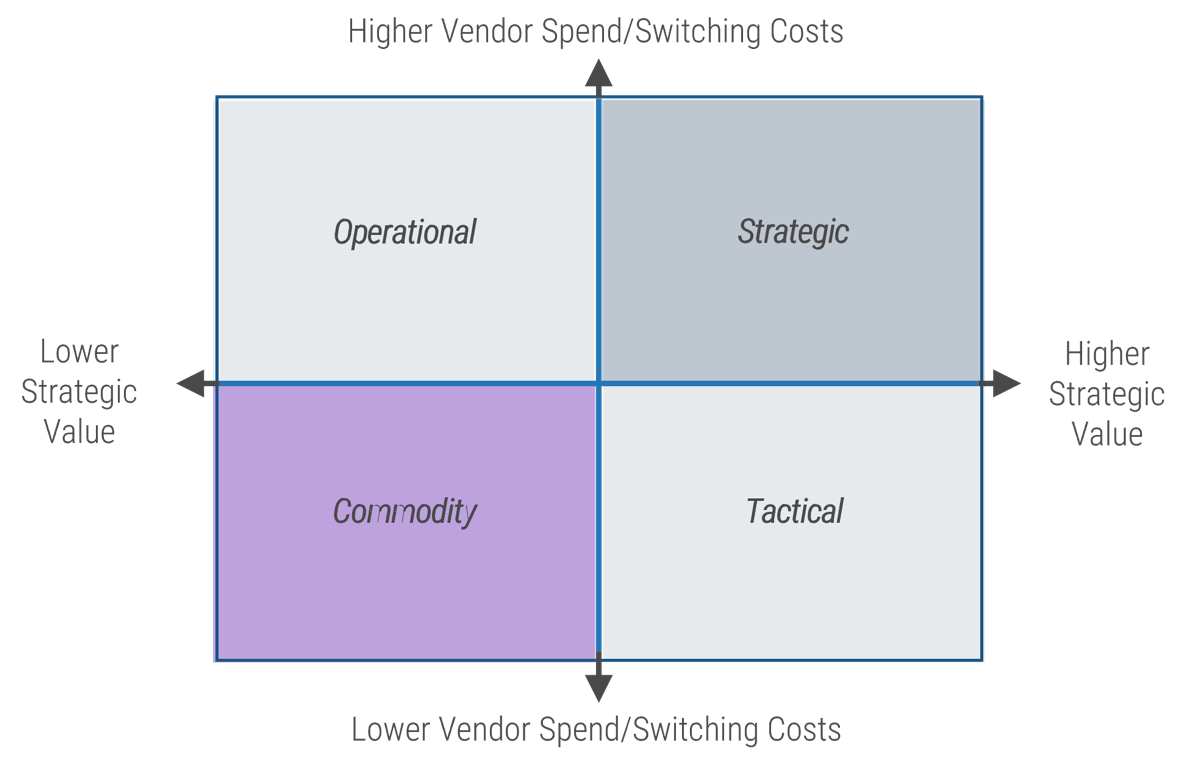
Info-Tech Insight
A VMI is a formalized process within an organization, responsible for evaluating, selecting, managing, and optimizing third-party providers of goods and services.
The amount of resources you assign to managing vendors depends on the number and value of your organization’s relationships. Before optimizing your vendor management program around the best practices presented in this blueprint, assess your current maturity and build the process around a model that reflects the needs of your organization.
Info-Tech uses VMI interchangeably with the terms “vendor management office (VMO),” “vendor management function,” “vendor management process,” and “vendor management program.”
3.1.4 Analyze product satisfaction and vendor management
1 hour
- Use the Get the Most Out of Your CRM Workbook, tab “6. Vendor Optimization.”
- Download the SoftwareReviews Vendor Scorecard.
- Using the scorecards, compare your results with those of your peers.
- Consolidate areas of improvement and optimization strategies in the Get the Most Out of Your CRM Workbook, tab “8. Optimization Roadmap.” (See next slide for screenshot.)
See previous slide for help around implementing a vendor management initiative.
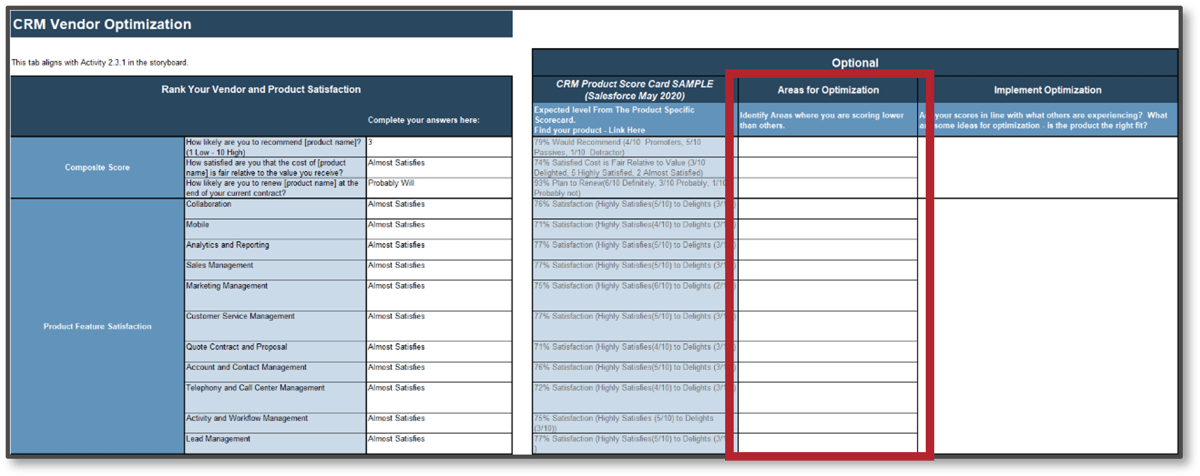
Plan your vendor management optimization strategy

Step 3.2
Compile Optimization Assessment Results
Activities
- 3.2.1 Identify key optimization areas
Build Your Optimization Roadmap
This step will guide you through the following activities:
- Use your work from previous activities and prioritization to build your list of optimization activities and lay them out on a roadmap
This step involves the following participants:
- CRM Optimization Team
Outcomes of this step
- Application optimization plan
3.2.1 Identify key optimization areas
1-3 hours
Before you can make changes and optimization decisions, you need to understand the high-level costs associated with your current application architecture. This activity will help you identify the types of technology and people costs associated with your current systems.
- Consolidate your findings and identify optimization priorities (Step 3.1).
- Prioritize those most critical to the organization, easiest to change, and whose impact will be highest.
- Use the information gathered from exercise 1.5.1 on Get the Most Out of Your CRM Workbook, tab “9. Costs (Optional).”
- These costs could affect the priority or timeline of the initiatives. Consolidate your thoughts on your Get the Most Out of Your CRM Workbook, tab 8, “Optimization Roadmap.” Note: There is no column specific to costs on tab 8.
This is meant as a high-level roadmap. For formal, ongoing optimization project management, refer to “Build a Better Backlog” (Phase 2 of the Info-Tech blueprint Deliver on Your Digital Product Vision).
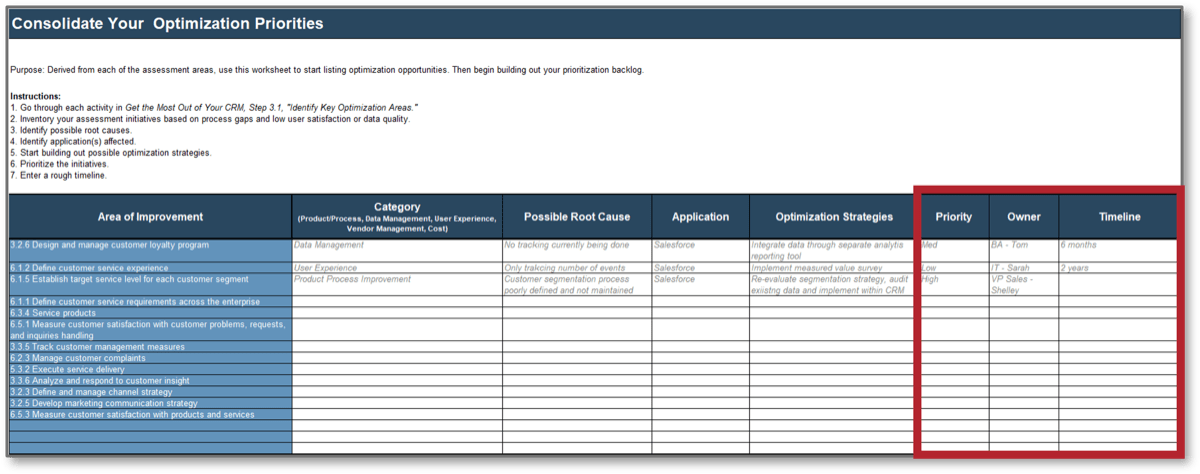
Next steps: Manage your technical debt
Use a holistic assessment of the “interest” paid on technical debt to quantify and prioritize risk and enable the business make better decisions.
- Technical debt is an IT risk, which in turn is a category of business risk.
- The business must decide how to manage business risk.
- At the same time, business decision makers may not be aware of technical debt or be able to translate technical challenges into business risk. IT must help the business make decisions around IT risk by describing the risk of technical debt in business terms and by outlining the options available to address risk.
- Measure the ongoing business impact (the “interest” paid on technical debt) to establish the business risk of technical debt. Consider a range of possible impacts including direct costs, lost goodwill, lost flexibility and resilience, and health, safety, and compliance impacts.
- When weighing these impacts, the business may choose to accept the risk of technical debt if the cost of addressing the debt outweighs the benefit. But it’s critically important that the business accepts that risk – not IT.
Take it a step further…
Deliver on Your Digital Product Vision
Phase 2: Build a Better Product Backlog
Build a structure for your backlog that supports your product vision.
Build a better backlog
An ongoing CRM optimization effort is best facilitated through a continuous Agile process. Use info-Tech’s developed tools to build out your backlog.
The key to a better backlog is a common structure and guiding principles that product owners and product teams can align to.
Info-Tech Insight
Exceptional customer value begins with a clearly defined backlog focused on items that will create the greatest human and business benefits.
Activity Participants | ||||||||
|---|---|---|---|---|---|---|---|---|
Backlog Activity | Quality Filter | Product Manager | Product Owner | Dev Team | Scrum Master | Business | Architects | |
| Sprint | Sprint Planning | “Accepted” | ✔ | ✔ | ✔ | |||
| Ready | Refine | “Ready” | ✔ | ✔ | ✔ | |||
| Qualified | Analysis | “Qualified” | ✔ | ✔ | ✔ | ✔ | ✔ | |
Ideas | Intake | “Backlogged” | ✔ | ✔ | ✔ | ✔ | ✔ | |
A product owner and the product backlog are critical to realize the benefits of Agile development
A product owner is accountable for defining and prioritizing the work that will be of the greatest value to the organization and its customers. The backlog is the key to facilitating this process and accomplishing the most fundamental goals of delivery.
For more information on the role of a product owner, see Build a Better Product Owner.
Highly effective Agile teams spend 28% of their time on product backlog management and roadmapping (Quantitative Software Management, 2015).
1. Manage Stakeholders
- Stakeholders need to be kept up to speed on what the future holds for a product, or at least they should be heard. This task falls to the product owner.
2. Inform and Protect the Team
- The product owner is a servant leader of the team. They need to protect the team from all the noise and give them the time they need to focus on what they do best: develop.
3. Maximize Value to the Product
- Sifting through all of these voices and determining what is valuable, or what is most valuable, falls to the product owner.
A backlog stores and organizes PBIs at various stages of readiness.
Your backlog must give you a holistic understanding of demand for change in the product
A well-formed backlog can be thought of as a DEEP backlog:
Detailed Appropriately: PBIs are broken down and refined as necessary.
Emergent: The backlog grows and evolves over time as PBIs are added and removed.
Estimated: The effort a PBI requires is estimated at each tier.
Prioritized: The PBI’s value and priority are determined at each tier.
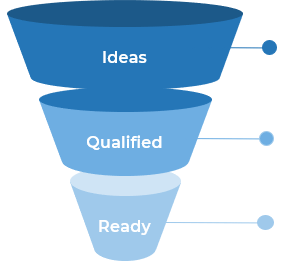 |
3 - IDEASComposed of raw, vague, and potentially large ideas that have yet to go through any formal valuation. |
2 - QUALIFIEDResearched and qualified PBIs awaiting refinement. |
|
1 - READYDiscrete, refined PBIs that are ready to be placed in your development teams’ sprint plans. |
Summary of Accomplishment
Get the Most Out of Your CRM
CRM technology is critical to facilitate an organization’s relationships with customers, service users, employees, and suppliers. CRM implementation should not be a one-and-done exercise. There needs to be an ongoing optimization to enable business processes and optimal organizational results.
Get the Most Out of Your CRM allows organizations to proactively implement continuous assessment and optimization of a customer relationship management system. This includes:
- Alignment and prioritization of key business and technology drivers
- Identification of CRM processes including classification and gap analysis
- Measurement of user satisfaction across key departments
- Improved vendor relations
- Data quality initiatives
This formal CRM optimization initiative will drive business-IT alignment, identify IT automation priorities, and dig deep into continuous process-improvement.
If you would like additional support, have our analysts guide you through other phases as part of an Info-Tech Workshop.
Contact your account representative for more information
workshops@infotech.com
1-866-670-8889
Research Contributors

Ben Dickie
Research Practice Lead
Info-Tech Research Group
Ben Dickie is a Research Practice Lead at Info-Tech Research Group. His areas of expertise include customer experience management, CRM platforms, and digital marketing. He has also led projects pertaining to enterprise collaboration and unified communications.

Scott Bickley
Practice Lead & Principal Research Director
Info-Tech Research Group
Scott Bickley is a Practice Lead & Principal Research Director at Info-Tech Research Group focused on vendor management and contract review. He also has experience in the areas of IT asset management (ITAM), software asset management (SAM), and technology procurement, along with a deep background in operations, engineering, and quality systems management.

Andy Neil
Practice Lead, Applications
Info-Tech Research Group
Andy is Senior Research Director, Data Management and BI, at Info-Tech Research Group. He has over 15 years of experience in managing technical teams, information architecture, data modeling, and enterprise data strategy. He is an expert in enterprise data architecture, data integration, data standards, data strategy, big data, and the development of industry-standard data models.
Bibliography
Armel, Kate. “Data-driven Estimation, Management Lead to High Quality.” Quantitative Software Management Inc. 2015. Web.
Chappuis, Bertil, and Brian Selby. “Looking beyond Technology to Drive Sales Operations.” McKinsey & Company, 24 June 2016. Web.
Cross-Industry Process Classification Framework (PCF) Version 7.2.1. APQC, 26 Sept. 2019. Web.
Fleming, John, and Hater, James. “The Next Discipline: Applying Behavioral Economics to Drive Growth and Profitability.” Gallup, 22 Sept. 2012. Accessed 6 Oct. 2020.
Hinchcliffe, Dion. “The evolving role of the CIO and CMO in customer experience.” ZDNet, 22 Jan. 2020. Web.
Karlsson, Johan. “Backlog Grooming: Must-Know Tips for High-Value Products.” Perforce. 18 May 2018. Web. Feb. 2019.
Klie, L. “CRM Still Faces Challenges, Most Speakers Agree: CRM systems have been around for decades, but interoperability and data siloes still have to be overcome.” CRM Magazine, vol. 23, no. 5, 2019, pp. 13-14.
Kumar, Sanjib, et al. “Improvement of CRM Using Data Mining: A Case Study at Corporate Telecom Sector.” International Journal of Computer Applications, vol. 178, no. 53, 2019, pp. 12-20, doi:10.5120/ijca2019919413.
Morgan, Blake. “50 Stats That Prove The Value Of Customer Experience.” Forbes, 24 Sept. 2019. Web.
Norelus, Ernese, et al. “An Approach to Application Modernization: Discovery and Assessment Phase.” IBM Garage, Medium, 24 Feb 2020. Accessed 4 Mar. 2020.
“Process Frameworks.” APQC, 4 Nov. 2020. Web.
“Process vs. Capability: Understanding the Difference.” APCQ, 2017. Web.
Rubin, Kenneth S. "Essential Scrum: A Practical Guide to the Most Popular Agile Process." Pearson Education, 2012.
Savolainen, Juha, et al. “Transitioning from Product Line Requirements to Product Line Architecture.” 29th Annual International Computer Software and Applications Conference (COMPSAC'05), IEEE, vol. 1, 2005, pp. 186-195, doi: 10.1109/COMPSAC.2005.160
Smith, Anthony. “How To Create A Customer-Obsessed Company Like Netflix.” Forbes, 12 Dec. 2017. Web.
“SOA Reference Architecture – Capabilities and the SOA RA.” The Open Group, TOGAF. Web.
Taber, David. “What to Do When Your CRM Project Fails.” CIO Magazine, 18 Sept. 2017. Web.
“Taudata Case Study.” Maximizer CRM Software, 17 Jan. 2020. Web.
